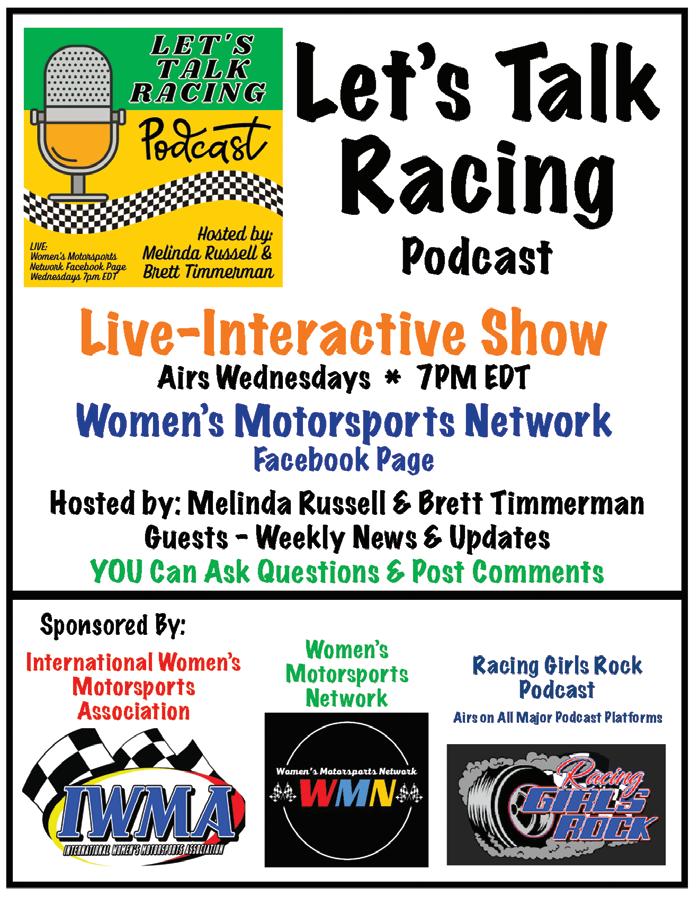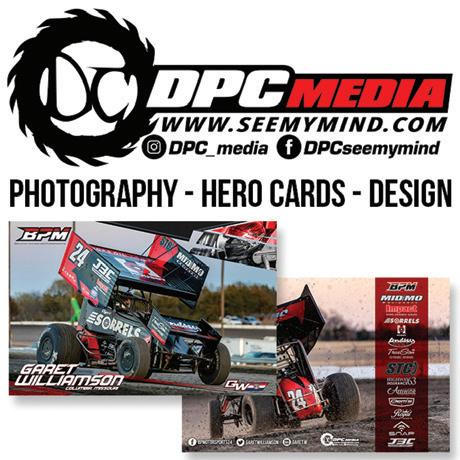






















OWNER/PUBLISHER
Adam Cornell
EDITOR
Justin Zoch
SUBSCRIPTION COORDINATOR
Abigail Cornell
WEBSITE COORDINATOR
Shaun Cornell
WORDS
Ashley Allinson, Ashley Zimmerman, Bert Lehman, Bill Blumer Jr., Bob Mays, Brett Swanson, Chad Meyer, Chris Romano, Cyndi Stiffler, Danny Burton, David Sink, Doug Kennedy, Doug Seeger, Elizabeth Madley, Eric Arnold, Gary Costa, Greg Soukup, Jessica Jenkins, Joanne Cram, Joe Duvall, Kelley Carlton, Kevin Oldham, Larry Weeks, Lee Ackerman, Melissa Coker, Mike Spieker, Odell Suttle, Scott Erickson, TJ Buffenbarger, Todd Heintzelman, Vahok Hill
PICTURES
Adam Mollenkopf, Andy Newsome, Bill Miller, Bill Taylor, Bob Mays, Bob Yurko, Brad Plant, Brandon Anderson, Brendon Bauman, Brian Bouder, Bruce Palla, Buck Monson, Buzz Fisher, Carey Fox, Chad Wells, Chris McDill, Chris Pederson, Conrad Nelson, Dan DeMarco, Danny Howk, David Campbell, David Giles, David Hill, David Pratt, Dennis Krieger, Don Laidlaw, Donna Rosenstengel, Doug Burgess, Doug Vandeventer, Glen Starek, Gordy O’Field, Greg Stanek, Greg Teel, Heath Lawson, Jacy Norgaard, Jason Orth, Jason Spencer, Jason Wells, Jeff Bylsma, Jim Collum Jr., Jim DenHamer, Jim Zimmerline, Jimmy Jones, Joe Orth, Joe Secka, John Dadalt, John Lee, John Rothermel, Jon Holliday, Joseph Swann, Josh James, Ken Kelly, Lee Greenawalt, Leif Tillotson, Mark Funderburk, Mark Sublett, Matt Butcosk, Michael Diers, Michael Moats, Mike Campbell, Mike Damic, Mike Feltenberger, Mike Howard, Mike Musslin, Mike Ruefer, Millie Tanner, Patrick Miller, Paul Arch, Paul Gould, Quentin Young, Rich LaBrier, Richard Barnes, Rick Neff, Rick Sherer, Robert Wing, Rocky Ragusa, Ron Gilson, Ron Sloan, Ryan Northcote, Scott Swenson, Seth Stone, Steve Walters, Tanner Dillin, Tara Chavez, Terry Page, Tim Aylwin, Tim Hunt, Todd Boyd, Tom Macht, Tony Hammett, Travis Branch, Troy Junkins, Tyler Carr, Tyler Rinkin, Zach Yost, Zakary Kriener

6
8
PAGE
Get up close and personal with the Smooth Operator himself, Bobby Pierce, on his stellar 2023 season.
We fielded your questions for Indiana’s Parker Price-Miller on all aspects of his racing career, including his battle with cancer, his ability to ride-hop so successfully and also on what made him jump into a late model while still pursuing his sprint car dreams.
Sometimes it just works out that way. Bobby Pierce never intended to race for a World of Outlaws title in 2023 – he was set on winning the Rookie of the Year honors and building his team for the future. He just so happened to have a career year and is knocking on the door of a title. We check in with Pierce to see what made everything so magical in 2023.
One of the most competitive fields ever assembled gathered in Knoxville, Iowa, to chase after the most prestigious sprint car race of the year but after four days and hundreds of laps, the final 50 were all Kyle Larson. He was the headliner but there was plenty of other on track action captured by our photographers.
44
Cedar Lake Speedway never disappoints with their USA Nationals. This year was no different as a huge field, and crowd, watched young stars Bobby Pierce and Hudson O’Neal go toe-to-toe for a big check again in the 2023 season.
We tasked our photographers with digging through their archives to dredge up some of their favorite photos from over the years at the World 100. There are a lot of new high-paying events but nothing comes close to the World 100 for history and significance and these photos shows us exactly what made it the best.

SOMETIMES HOW YOU react IS the solution. When adversity strikes, how you react can be the difference between life and death. When success strikes, how you react can be the difference between continued success and eventual failure.
But how does one know how to react in each situation? Faith, experience, maturity, natural ability, a great support system, excellent mentors; these are all great guiding forces. Choosing the right one when the moment arises is the tough part.
One thing I’ve learned in life though, is rarely does it work out well when decisions are made in fear. A panicked decision is hardly ever a good one.
As I look at the dirt track racing industry this year, I’ve found myself riding a roller coaster of emotions. There has been some amazing racing in 2023. It seems like we’re living in a golden age of access to all levels of dirt track racing, thanks to the advent of internet streaming. The costs of putting together a relatively professional looking internet video stream have come down to the point that it’s feasible to send one or two people out to an isolated track and allow the world to feel like they’re in the grandstands, whereas in the past you had to have a veritable TV truck to push out a broadcast. Has it equaled more butts in the seats? That’s tough to say. Many of the larger events have been absolutely packed. Other, smaller, or more regional events have found both car counts and ticket sales to be down.
Lower car counts aren’t the only not so promising things going on. Over the last month or two there have been multiple tracks that have closed, or at the very
least, gone up for sale. (One wise internet sage commented that “in reality, a racetrack is ALWAYS for sale.”) The variety of reasons are plentiful, but in multiple cases it has to do with the age of the owners and a desire to retire. Still in at least a few other cases it’s been outside forces looking to shut down a track at the behest of neighbors who don’t like the noise or dust. I still have trouble comprehending how you can buy or build a house next to a racetrack and then believe you have the right to try to foment a movement to get it shut down. It’s like buying a beach house and yelling at the sea to hush!
When it comes to the lower car-count issue we’ve got economics and the interest from the next generation of drivers that are proving to be a stressor. Everything has gotten more expensive just to put a car on the track, let alone to fuel up the hauler to get it there in the first place. Smaller teams are the first to bow out from competition, and the more well-funded teams are feeling the pinch as well. Lower car counts equals lower ticket sales, by simple economics.
Whereas in the past you didn’t have to do much to lure kids into wanting to go to the track or be a part of racing, now there is so much competition for their attention that there seems to be fewer young people getting involved with the sport.
How are we to react? How do we reverse these trends?
Well, reacting in fear won’t help. Finding ways to work together within the racing community can provide solutions. Many tracks that are neighbors have found salvation in working out a schedule that allows for each venue to run programs that don’t conflict with each other. Tracks who collaborate with rules can be helpful in upping the car counts at each track as well.
As far as getting fans in the grandstands, tracks have definitely become better at online marketing and letting more people in their areas know about upcoming events, but it can always be improved upon. Ticket giveaways with local radio stations still work, and putting together meet and greets featuring drivers and cars with local elementary schools for the kids to get up close to a
real race car can do wonders for getting new fans to try a night at the track.
All in all, I can only say those immortal words from a silly book written by Douglas Adams back in 1979: Don’t Panic. Even if you’re not a fan of The Hitchhiker’s Guide to the Galaxy, you can find some solace in those words.
Control what you can control, and don’t worry about the things you can’t. Find moments of joy in each day and in each moment we have dirt track racing, whether in person or by watching a stream. Support sponsors whenever you can and let them know you support them because of their ties to dirt track racing. Reduce the amount of complaining (especially on social media) and look for ways to encourage others in the racing community.
And remember, don’t panic.
There may be a day in the future when dirt track racing ceases to exist (may that day never come!) but worrying about it now will just rob us of the joy we could be experiencing by appreciating what we have in the here and now.
I refuse to borrow tomorrow’s trouble. I’ll look on the bright side and keep creating a magazine that captures the great moments of the sport I love for as long as the engines roar and the dirt flies. I’m confident you’ll be along for the ride.
Now, enough doom and gloom.
Let’s go racing!

 Photo: Melissa Tousley
Photo: Melissa Tousley

LOAD MANAGEMENT. Those are two very dirty words in the sports world. It is the idea of sitting your star players to preemptively give them rest and avoid injury so they are at peak performance for the playoffs, instead of a Tuesday night road game. It’s a practice most often employed in the NBA but one that will certainly be finding its way into other sports and activities, too. If you were forced to watch any of the NFL preseason, it’s alive and well. The NBA is doing its best to resist it as much as possible because fans pay big money to see Lebron James or Nicola Jokic not sit on the bench the one time they pass through a place like Minneapolis each year.
I always like to compare our sport to the Big Four (Football, Baseball, Basketball and Hockey) and find parallels. This idea raises several important questions. Will this particular practice infiltrate short track racing? Will it be allowed to? Finally, should it be allowed to happen?
In the weeks prior to this year’s Knoxville Nationals, Jacob Allen abruptly left the World of Outlaws tour and skipped a Saturday night World of Outlaws race at Williams Grove Speedway and then was replaced in the car just before the Nationals. In between the Grove and Knoxville, Jacob released a post talking about the strain of the road and asking for grace and the possibility of more down time for racers.
The World of Outlaws schedule, for both sprint cars and late models, is absolutely no joke and aside from a little time in early November through January, there is very little time to spend at home. Most major racing series have gone to
a contract model that basically requires attendance at every event, except in the case of injury, and offers no free passes for weddings, funerals or vacations. It’s the way it has always been but now it’s on paper. Racing has always demanded everything from everyone to make it at the highest level. That commitment is often what separates the greatest from the very good. There’s no mailing it in or going hit-and-miss. And, increasingly, as if there ever really was, there is no offseason. To make it, racing has to be your obsession, not just your profession.
But does it have to be this way? In this issue, Kendra Jacobs talks about her time at the Knoxville Raceway and the career choices that have defined her and says “One of the biggest challenges of a career in motorsports is finding a work-life balance. It’s extremely difficult. Beyond the extensive travel and weekend work, the industry really consumes you. It’s hard to make friends or have relationships outside of the sport. I would tell my younger self to make the time away from work a bigger priority.”
Allen officially said that he needed some time to focus on himself and his family. For a young man who spent ten years on the road building a career with the family-owned Shark Racing Team, this may just be a blip in his racing career or it may be an irreversible decision that launches the next phase of his life. Time will tell. However, it is clear that Allen opened up a conversation that is just starting.
In a sport that is defined by obsession and chasing points and wins and where every second, every spot counts, would it be the end of the world if a driver skipped a few shows a year for a family wedding or simply go to the mountains, if that’s what keeps them going? It might be. Our sport currently values contracts for racers to only show up at certain shows and that likely isn’t going away. It will only get worse as streaming opens up more options for more racing like High Limit for sprint cars and XR for late models and series get even more provincial. The big money is in the contracts and the point funds, which leaves very little room for racers that want to take a weekend off now and then. There has never been
more money or more races or more competition in the history of our sport – late models or sprint cars – and that competition has driven the legacy brands like the World of Outlaws Series and Lucas Oil Late Models and the All Stars to cling all the tighter to their assets. They need their brand to be represented every time they hit the track – you’re in or you’re out.
I don’t know the right answer. We love racing because of the dedication required but will that ultimately be to the detriment of the sport? I don’t know. Not under the current business model. Racing has never rewarded anything but the latest results.
There is a lot of money to be made right now in this sport but don’t expect any time off or any grace – with more opportunities come more competition, which always works against a work-life balance. Kudos to Allen for raising the issue but, for now, he’s going to need a lot more like-minded individuals to start a revolution.
[Just as we went to press, Anthony Macri released a similar message on Facebook saying he agrees with Allen’s sentiments and also just needed some time away from the time commitment of racing full-time to focus on other things. Is revolution fomenting?!]


BACK IN AUGUST I read a tweet by writer Matt Weaver asking what motorsports meant to me/you and, in contemplation of such a simple question, I came to realize the answer was more than the character spaces allowed in one simple tweet (or whatever you want to identify Elon’s app as these days.) As a child, motorsports, more specifically sprint cars, were the connection I forged with my father. When I lost him at age at seventeen, sprint cars would be the connection that made my life feel
RACING HAS BEEN AN INTRICATE PART OF MY ENTIRE PERSONALITY SINCE I TOOK MY FIRST BREATH, AND THIS DETAIL I KNOW I AM NOT ALONE IN; BUT IT IS SHOCKING AT HOW QUICKLY I’VE FORGOTTEN THE ADVENTURES MOTORSPORTS HAS ALLOWED ME TO EXPERIENCE.
whole; it filled the space in my heart that ached from the loss of him. Sprint car racing would become the defining details of where I found peace as I navigated a world as a young woman without her father. The friendships my father made in sprint car racing, at Knoxville Raceway would be the very individuals who shared stories of his days before my birth into the world; they would share in his pride of having me as his daughter, and they would help to guide and navigate me through life filling the gaps of having one less parent.
Sprint car racing was where I found my voice in sharing the emotion of a sport derived of metal, engines, fuel, and dirt. Sprint car racing would be the world where my crazy colored hair, tattoos, and piercings acquired no judgement, a drastic difference from competing in the horse world as a barrel racer and employment from horse trainers. From sprint car racing, I grew into adventuring into the world of late model racing, modifieds; all of motorsports and with this growth motorsports would bless me with incredible mentors, positive friendships, and a sense of purpose that seventeenyear-old me lost without her father, had felt passed in the same breath he did. More importantly, motorsports would place me at the very racetrack where I would cross paths with my now fiancé and bring the sense of home, I felt at a racetrack into the place I called home away from the racetrack.
I’ve sat with the question - what does motorsports mean to you? - over the course of this week, and continued to find ways in which I could add to the beautiful picture my answer curates with so many details I had been absent in realizing their roots traced back to one singular tree. Racing has been an intricate part of my entire
personality since I took my first breath, and this detail I know I am not alone in; but it is shocking at how quickly I’ve forgotten the adventures motorsports has allowed me to experience.
More often than not, leaving the Knoxville Nationals I’m met with emotions of sadness and melancholy at how very little is left of the race season, but as I’ve spent time finding the words to define such a simple question, I’ve found I feel more hopeful and excited in seeing what is left to grow and come from racing. As this season begins to wind down, I pose the very question Matt Weaver posed on social media this week, what does motorsports mean to you? I’ve spent hours interviewing race fans, drivers, and crew members; we are not that different in our passion for the sport we live for; in the peace we find. However, the fine details that define how intensely we feel for our moments in our heaven on earth, those are fine-tuned uniquely to each and every one of us, and I’d love to hear the answers to a question too short for an app owned by Elon.




Said every crew chief ever!
Ransomville sportsman racer Tyler Moore ain’t ashamed to have non-biodegradable strips of plastic holding his dreams together. Photo: Paul Arch
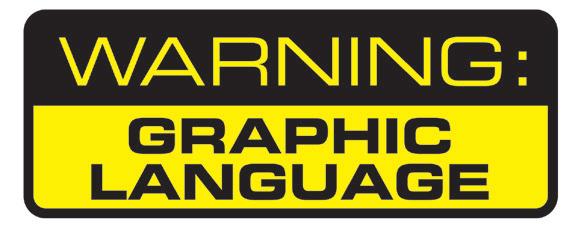
ASIDE FROM SPONSORSHIPS, racers use their cars to convey everything from politics to jokes and to express their personalities. Here are some of our favorites from the last couple of months.

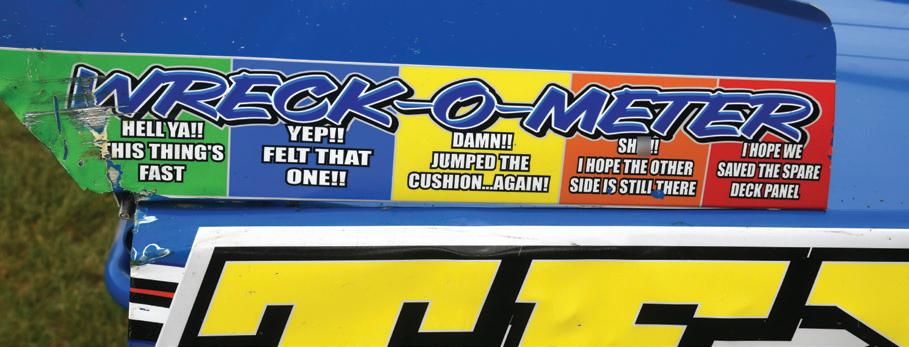

Finally, something we can all agree on. Buying a race car may be one of the most exciting decisions a person ever makes in their life but very few would also qualify it as one of the best financial decisions of their lives!
The Scale of Destruction! Semi-lates competitor Michael Laughard takes a humorous approach to just how much damage he can do when he’s out having too much fun.
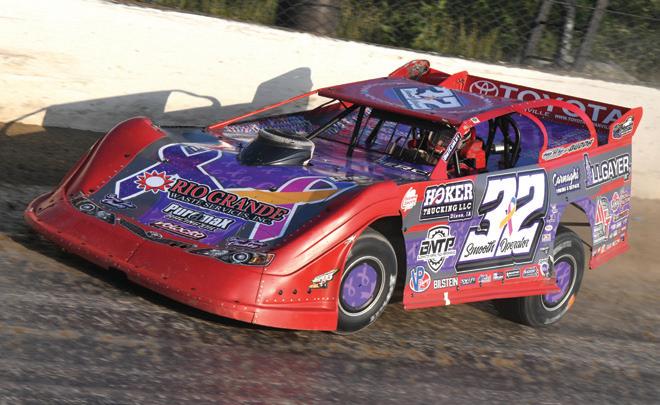 Photo: Paul Arch
Photo: John Rothermel
Photo: Paul Arch
Photo: John Rothermel



Dirt Empire is taking questions provided by YOU and will seek out your favorite drivers to get you the answers to your long awaited questions! All you have to do to submit your question is just Like Dirt Empire on any social media and include #DEasks with your question. Then watch for the next issue to see if your question is featured!
BY ASHLEY ZIMMERMANTHIS YOUNG MAN has been through it. He’s fought hard to get to the pinnacle of sprint car racing and he’s used his tenacity and talent to find good rides and race at the highest levels of the sport. When a ride isn’t available, he takes his own car racing and quickly proves worthy to another car owner.
It hasn’t been easy. Since the pandemic started and shut down his
profession for a spell, Parker PriceMiller has also had to battle cancer and a broken back sustained at the 2022 Knoxville Nationals. He fought hard and even challenged himself by buying his own late model to expand his horizons. Parker Price-Miller’s got a lot going on and we fielded your questions for him in this edition of DEAsks.
Dirt Empire: Let’s start by discussing how you shocked everyone by not only hopping in a late model for the World Finals but even purchased your own. What made you want to venture over to the world of fenders?
Parker Price-Miller: Well, I think seeing [Kyle] Larson do it drove me to wanting to do it even more. But really seeing how big their races are, how much more
money they are able to race for, how well it’s supported by sponsors and things made me think I wanted to try and see if we could do it. Then when I got hurt at Knoxville, afterwards I kind of thought well maybe this is a bit safer than sprint cars, and while that wasn’t initially why we did it, it was kind of another additional plus side. But after doing it, though, it’s so much harder, it’s going to take so much more effort. It’s not going to be like Larson and going out there your first weekend in one and winning. After driving one, I’ve always thought Larson was great, but now, I don’t get how he does it.
DE: What would you say you’ve struggled with the most transitioning into a late model?
PPM: For one, in a sprint car you sit in the

middle of the car, your right rear is kind of just right off your butt. You don’t really feel like your right rear is way out there. It’s much easier to run the fence and tell where your right rear is at. In the late model, it’s so much longer and wider than a sprint car, I had a hard time adjusting to figuring out where my right rear and quarter panel was. Sprint car racing, you drive a lot with the brake, we don’t really lift much in the winged sprint cars. With the late model I was just trying to drive it too hard, I was making myself even more tight because I wasn’t giving it a chance to rotate itself. They drive a lot more off of the throttle more than we do, you have to lift and just smash it back into it. Where we drive in hard, and then kind of back off the throttle. They are just totally different driving styles. The steering is different than ours. With ours the power steering is off like a one-sided arm, and with late models there is a steering column, and the ratios are different. There is a lot of different stuff going on between the late models and the sprint cars. Trying to do it part-time is just way too difficult for me. I enjoy driving both of them, but when I first get back into a late model, it’s so new, that I forget what I have to do at first. It takes me about half of the night to start getting used to the driving style. I’m very competitive, so it’s hard for me to want to go race them a lot because I know I want to do good and want to make money, but I feel like if I want to get better at it, I have to go do it more, right?
DE: When you first split from the McCandless 29 earlier this year, you mentioned wanting to race the late model a bit more, and we know you went to the Flo Racing night in America at Spoon River, but with this sort of learning curve, does this change your mind some about wanting to hit up more late model races?
PPM: I still want to, but we are coming into the heart of sprint car racing, and it’s kind of hard to focus on that [late model racing] when you know if you focus on your sprint car right now you could have a really good summer and make a lot of money. So, right now we’re just focused on sprint car stuff, getting that sorted out, and maybe a weekend if it rains
out, we might be able to bounce over to Illinois and go do some stuff. It’s just hard. I think we need to go run some local races, or maybe some of the MARS series shows, not saying I’m going to make the show, but it’s easier to make the show there. The races I’ve currently ran at, literally everyone in late model racing is at the show, and I only get qualifying and an eight-lap heat race and then the B main. I just need to get as many laps as possible right now. The problem with that is, you can go test as much as you want, but I’m fine testing, it’s being around other cars that I’m struggling with because the aero[dynamics] side is way different with sprint cars.
DE: While this season has been a little rocky already with leaving the
 Photo: Josh James
Photo: Matt Butcosk
Photo: Josh James
Photo: Matt Butcosk

McCandless 29 and doing some ride jumping, how do you work through that to be able to find momentum and consistency again?
PPM: Well, I take the same crew chief with me everywhere I go; Kevin Osmolski, we work really well together. He was with me at McGhee last year, too. McGhee at the end of last year just didn’t want to race anymore, so we left there and started building our own team, and then the McCandless deal sort of popped up. All of our cars are the same as McGhee, well technically now they are, I was running a different frame earlier in the year, but we switched over to what they were running last year.
DE: When it comes to the Crown Jewel races and the month of money, do you ever find yourself looking forward to any one in particular?
PPM: Up until this year, nothing had ever paid over $200,000, and in the past few years Eldora has really put up more money for the week of the Kings Royal with adding back in the Historical Big One, and that was really fun. You always kind of look forward to that week. The Knoxville Nationals, Knoxville has a special place in my heart, I don’t know why. Probably because it’s the first Crown Jewel that I ever made. These races are
hard to make when you get 100 cars at every one of them. In 2018, I got fired from my ride, and built a car myself and went to the Nationals and made the feature with myself and one other guy. That’s put a special place in my heart to always want to keep going there and better myself. I feel like Knoxville is the most prestigious, they might not pay the most this year, but I feel like if you ask anyone in sprint car racing, they are going to say they want to win the Knoxville Nationals before they retire. Obviously, paycheck wise, you want to win the Million, but I’ll take either of them! But between Kings Royal week and the Knoxville Nationals, you don’t get much better than those two.
DE: The last couple of years have not been very kind to you, with battling cancer, and then the injuries sustained at the Knoxville Nationals. You’ve overcome a lot to continue racing. When things were at some of their toughest points, how did you push through and keep fighting?
PPM: I tried really hard to not feel sorry for myself and remind myself that other people have it worse than me. There for awhile I was really down and felt sorry for myself and was kind of doing the poor me stuff. There’s nothing wrong with that, but you aren’t going to succeed
with that attitude. I remember going to a doctor’s appointment in Indianapolis and there were young kids with probably more aggressive cancer or illness than what I had going on. Seeing that made me realize that you know, I don’t have it as bad and I should be thankful that my doctors found it when I was in stage two. That gave me a very good chance at beating it, whether or not I had to go through chemotherapy. No one wants to go through that, but there is always someone going through something worse than what I had. I always tried to stay positive through all of that and tried to never get down. There were times I was just beat; I would get back to the toter and get sick and didn’t feel good at all. But I wanted to race, and whenever I was in a race car, I was able to escape and forget about what was going on, forget about the treatments, and it was just racing. But the minute I went home is when I would feel worse, so racing was my escape and I wanted to keep doing it. I started feeling pretty good around the end of July, we were getting pretty fast, and then had a really great nationals going. Then I got hurt, I remember getting rushed to the hospital, we didn’t have any scans back or anything yet, but I just knew. I saw my mom and I was like my back, my neck, its broken, I just know it, it’s hurting so bad. It was only my
Photo: Paul Arch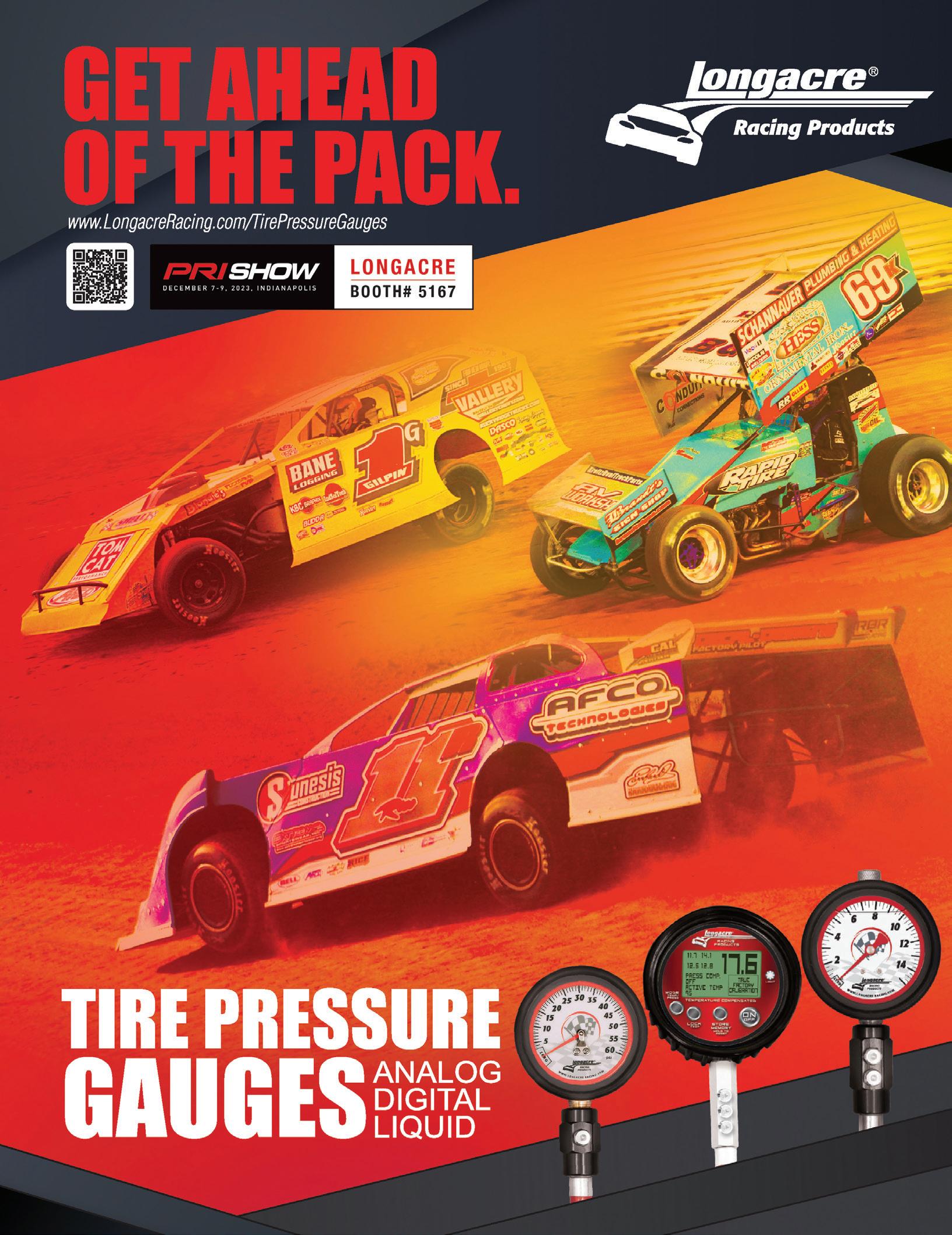

mom and I then and I remember saying, what have I done wrong? I’ve busted my butt, I’ve worked hard, I haven’t let anything beat me down, and here I am getting knocked down again, I don’t know what I’ve done wrong, we had a good cry session. Then I went home, and I started repairing myself again for the 2023 season, and now here we are, with hopefully no more setbacks.
DE: Was there ever a point through everything where you questioned should I even get back in a car? Or was getting back in the car the driving force in getting through everything?
PPM: I always wanted to. No matter what anyone said, I wanted to race. When I was going through chemotherapy, I remember one night I felt like I was having a heart attack, I got rushed to the hospital where they did some testing and some scans, they found out that I had blood clots in my lungs. They had to put me on blood thinners and I was supposed to be starting to race. They said, you know, you can’t race on these blood thinners, if you crash or something, you could bleed to death. My mom’s a nurse, so she was freaking out, too. My doctors though, they did a great job, they sent me to a blood doctor in Indianapolis, she knew

everything about blood thinners, you know when to take them, how long they work, when you shouldn’t take them. She said, so you want to race? I said, well yeah, I need to race! She said okay, well take this at a certain time, you know don’t take it x hours before a race, and we kept racing. I wasn’t going to let anything stop me. I had non-Hodgkin’s blood and blood, so it was in my bones and blood, obviously. It was mostly in my leg and at one point they were mentioning wanting to amputate my leg. I was like, you are not cutting my leg off that’s the only way I can still race, you are not cutting my leg off. I always knew I was going to race again, there were doubts deep down in my head that I may have never gotten to race again, but I wasn’t going to let that happen.
DE: Do you ever feel that after overcoming so much to stay in a sprint car that you view your opportunities differently?
PPM: I feel like I used to put a lot of pressure on myself, and I still do, but not as much. I used to think that racing was all there is, there was nothing more or nothing less in life, just racing. After going through what I’ve went through, I realized that there is just so much more to life. I remember when I was really sick, that I just needed to get out of the house and do something, so I went for a walk around my neighborhood, never would I have been so thankful to just be able to go for a walk; I remember thinking to myself during that walk there’s so much else to be appreciative for than just racing. Now, I try to view more as it’s my job, and it’s
Photos: Josh James
had a productive week at Southern Iowa Speedweek, running fourth in the 360 Nationals, 17th in the Front Row

how I make a living, but also try to go have fun, enjoy myself, and not put too much pressure on it. I try to remember that my life isn’t that bad if I don’t win this race or don’t do perfect. At the same time though, at these big races, there is a lot of energy, and a lot of pressure from fans to drive yourself to do well. I feel like I do better there is that atmosphere to push you harder in those situations.
DE: Through it all, what would you say is the biggest lesson you’ve taken away from sprint car racing?
PPM: My biggest takeaway from racing is get out and travel. I feel like I get to see so much of the world, well, I like to say that but we also don’t get to see a lot of it because we go from track to track, and don’t get to go from tourist site to tourist site. I’ve got to see a lot of cool things and a lot of cool places. There’s just so much more than what it’s in your hometown. It’s really good for your soul to get to go out and experience things.
DE: You’ve had the opportunity to try a lot of things throughout your racing career, is there anything you haven’t gotten to race or a position in racing you’ve ever thought about trying out?
PPM: I would really love to try Silver Crown racing; I’ve never tried that. I think they are really cool cars; the original Indy Car. They run pretty straight, so me being a wing guy, I feel like I would be somewhat successful, or able to have success, with
just how straight we run our cars. My dad promoted races at Kokomo and Terre Haute, and I would like to when I’m older to promote a wing race at Kokomo. I feel like that track is so awesome, and it’s my hometown track. I think it would provide a really cool Crown Jewel type race there,
but Crown Jewels require a lot of seating and Kokomo doesn’t quite have enough seating to hold enough fans to support that so maybe one day. So, I’d say racing a Silver Crown car and bringing a Crown Jewel to Kokomo.”

WHEN THE DISCUSSION of committing to the World of Outlaws series arose around Bobby Pierce, the concept may have been one surrounded in humor, but as Bobby Pierce has marked notches in the win column, he couldn’t appear more serious in his fight to claim not only Rookie of the Year honors, but the World of Outlaws series championship at season’s end. While the season started with an increased level of difficulty after struggling through Speedweeks at Volusia, Pierce hit smooth sailing through the mid-season cashing checks that most drivers and teams wish to sprinkle throughout their career let alone an entire season.
No stranger to Dirt Empire’s pages, we sat down with the current World of Outlaws points leader, to dig a bit deeper into the mind of Bobby Pierce to discuss the season, the driver, and even a few hot takes!
Dirt Empire: Let’s just get right into it. At the beginning of this season, you made the switch to running Longhorn chassis versus the chassis your father [Bob Pierce] built in house. What do you feel have been some of your biggest adjustments?
Bobby Pierce: Right away when I got into the car before Vado, we had a test session in Amarillo, Texas, at the track there, and within half a lap, I was already going into the next corner wide open. I think they [Longhorn chassis] fit me really good. The car felt great right off the bat, the only little adjustment is just getting used to the cockpit, the front bars you look out of are a bit different, just small things like that. Then it was just getting used to how the car drives into the corner, at about the apex point, I noticed the car feels very balanced where sometimes with the Pierce cars they sometimes

felt like they weren’t as balanced as they needed to be. With Longhorns, I’ve noticed they have really good balance to them. You will hear drivers talk a lot about balance in the car, it’s a really big deal.
DE: A change from chassis built in house to Longhorn’s is bound to cause people to come up with wild theories behind why the change was made. What really sparked you to make the change?
BP: Well, my dad didn’t want to keep doing things forever, [he laughs], he’s 71 years old now. He’s still building modifieds, but I could tell over the last few years he was really trying to slow down a little bit. Of course, he always wants to help me out as much as he can, that’s always been one of his main goals since I’ve started racing, he has always been determined to make me the best I could be, whether that was in a Pierce car or whatever I end up in. A few years ago, I

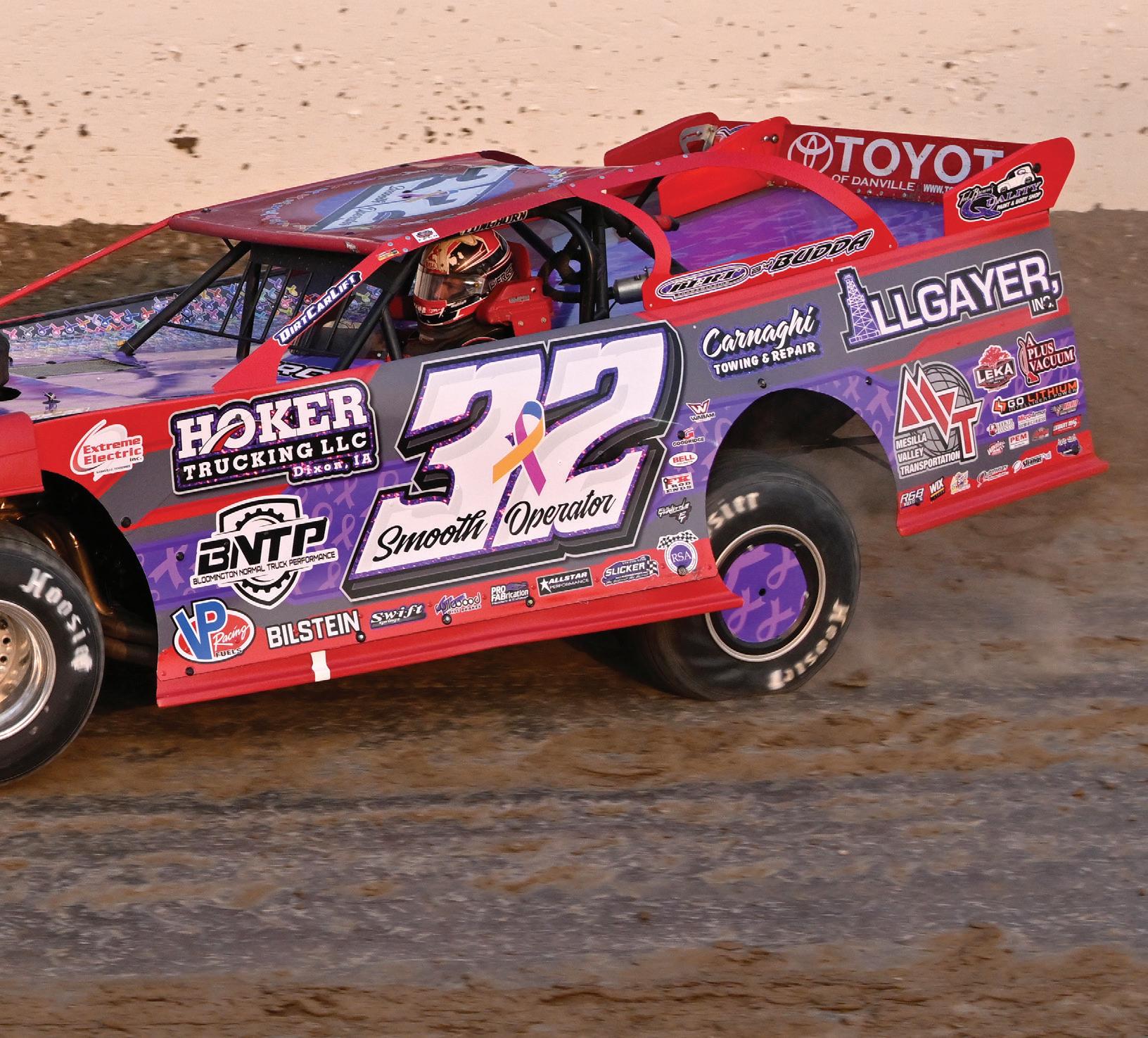
switched to Rocket, and he was sort of doing the same thing then, wanting to slow down, but then we ended up going back to Pierce cars. But this time he was definitely ready, he didn’t want to build late models anymore. It sort-of took me saying let’s pull the trigger and get into Longhorns for him to fully make the decision, but I could tell that’s what he wanted to do. He was very supportive, no matter what the case was. We chose Longhorn because we saw the success
guys like Davenport, T-Mac, and Overton, and all of them guys have had over the last few years and they looked like really drivable cars. I saw Davenport win in the slick, win on the cushion, so I knew they had to be pretty versatile. My dad knew Steve Arpin from racing modifieds; I met Steve when I was 6 or 7 years old, I always remembered Steve as a really cool dude. With Steve essentially being the owner of Longhorn, we thought it’d be a really great fit.
DE: This season, you took to social media to take sponsorship opportunities outside of the normal box, and shared with your following that you had lost a long-time sponsor and were seeking some space on the car to fill. While it has worked out very well for your team, you received quite a bit of differing opinions on the process. Now that the dust has settled, what is your take on utilizing social media for opportunities like this?

BP: When you’re looking for sponsorship, you have to let your pride go. A lot of people don’t want to put themselves out there and ask for sponsorship, sometimes you just really don’t want to have to do that. The hard facts are, as much as you don’t want to do that, you have to do that. When we lost Allgayer, he had actually told us in the beginning of the year that he would have to slow his sponsorship things down, so he wasn’t in a place to sponsor me like had in years past, so I knew in the beginning of the year. I had just kept him on the car in case things had turned around or changed. We have a great friendship. Sometimes it feels a little vulnerable to put yourself out there, and sometimes people think you’re just trying to get money. A lot of people just don’t understand what it takes to do this [race], ya know, the tire bill this year is probably going to be $120k, the motor bill who knows, shocks, paying crew guys, and crew guys aren’t cheap now a days especially if you want to keep them. It’s a lot of expense and we can’t do it without sponsors. The raffle idea I got from Rico [Abreu] and how he did his. We had to figure out a lot of logistics behind how to do it, get it on the website, but
now we have a sponsor for the month of September, and when October rolls around we’ll do it again, we’ll pull from the same names, they don’t have to purchase again.
DE: You’ve always really embraced social media, from Facebook to even Tik Tok, and really allowed your fans to interact with you creating quite a large following. How do you think this has built your relationship with your fans?
BP: I honestly don’t do enough stuff. It’s great to do race updates, but we always try to take it a step farther and show some personality behind it. I spoke about Rico, and he does a great job at this. I’ve noticed that a lot of fans don’t think that I work on my car, and it’s not that I care that people think this, but I was out there last night until 5 am working on the car, so when I say that we don’t do enough stuff, these are things I want to be able to show them, to let them see more and be involved more. It’s really important to build a good social media following and fan base. When fans go to watch races, they need a connection to drivers to make it more interesting for them to watch.
DE: Your girlfriend Abby brings fans behind the scenes on her own social media platforms allowing them to be even more connected to you. How do fans respond to that?
BP: Oh, they eat that up. I really have to thank her for doing that. Really for us, it’s a lot of fun. She has a lot of fun with it, I get a laugh out of her videos, and people really get a good kick out of it.
DE: At the start of the 2023 season, you announced committing to the World of Outlaws tour running for Rookie of the year honors. What about this year made it the year to commit to the series?
BP: Well, it all started last year during my fifth Summer Nationals tour; it was my fifth Summer Nationals championship. It’s great to be able to go run the Summer Nationals tour and win, you can make some really great money, while getting UMP points, so sometimes you’ll win them both, and really pick up some good money at the end of the year. I was just kind of watching the Outlaws schedule, and how there were some tracks on it that I wanted to get to. I really felt like it was the prime time to be on the tour. Our crew guys also mentioned wanting
Photo: Jeff Bylsmato do it as well. Then Steve Francis joined the tour, as well as Ruben as the announcer. I’ve always really got along well with Ruben and the Outlaws officials. It became one of those deals where I kind of joked, we’ll see how Vado goes, and then Vado went really well, right? [he laughs] So then I said, well let’s see how Volusia goes, and the first round at Volusia, for the first Outlaws’ race didn’t go too well. We kind of questioned what to do, so we went back the second time in February, and I won the very first night. After that it was like, we are for sure going to stick with this deal and see where we end up, and now we’re leading the points!
DE: Obviously, at the beginning of the year you had different expectations for yourself and how you wanted this year to go. How does what you wanted and where you are compare now?
BP: I definitely did not think we’d be where we are now. I kind of hoped for it, but at the beginning of the year, and I’ve even told a lot of people this, getting into the Longhorn, the different shock program with Bilstein, we had a lot of things going, and I had no idea how it would go. But right off the bat, at Vado,
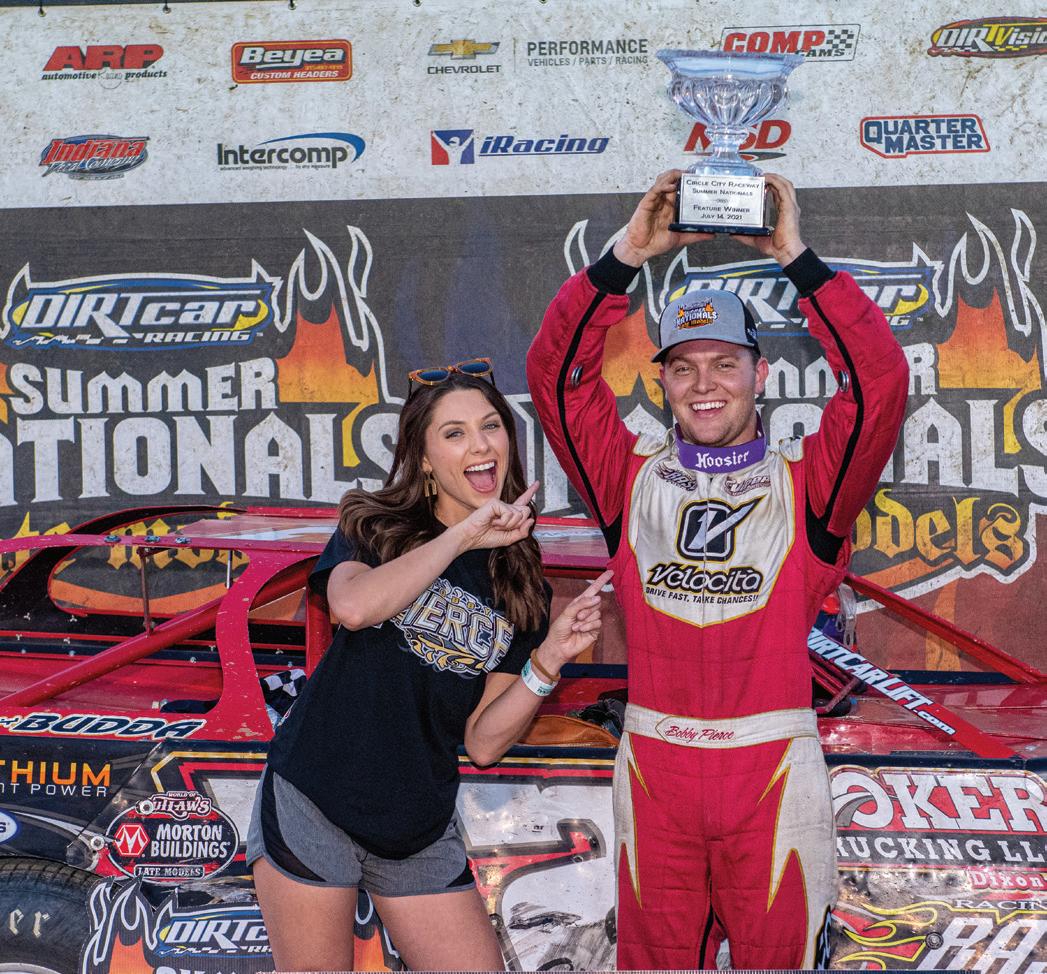


When we went to Volusia and it didn’t go well, I actually had to race the Big Frog Motorsports car the second night I was there, we didn’t have a back up car, something was wrong with ours, and then something happened to my car during the race, so I was like man, what am I going to do? I didn’t have a car to race for the feature but had just received an emergency provisional. They blew the tenminute horn, and I was looking around for a car to drive. Chris Ferguson had been driving the Big Frog car, but just missed making the A from the B, so the car was just sitting there. Scott Bloomquist had been driving the car earlier in the week, so it had his seat in it, I couldn’t reach the pedals, it was a cluster, but I hopped in it, it had the same tires and set up from that
how Scott likes it, and went from 28th to 17th so a decent run. After coming out of Volusia, we really didn’t know how it was going to go. Then we were leading the race at Talladega and broke a wheel with two laps to go for $50 grand and that one really sucked. We were trying to make up points since I was so far behind, and then we just started winning races, and if I wasn’t winning, I was second, and now here we are. We’re definitely a little shocked, and our goal this year was to go win races, those are always our goals and expectations. But to win this many, and that many big ones, that’s a thing that really sets a season apart from others.
DE: Speaking of wins, you were recently a part of a very big
transponder. What is your view when it comes to determining race wins with a transponder?
BP: The big argument is they use transponders to score every single lap anyways, so it makes sense to use it on the last lap, too, right? I do like it, I know how things can be, this eliminates there ever being a question in the event of a judgment call. You take the human element out of it, there’s no ifs, ands, or buts or anything like that. It’s just what the transponder says. In that specific scenario, it really doesn’t get much closer than that. I mean, .002 with a transponder, that might be even less than 1/8th of an inch of a transponder forward or back, it’s pretty crazy, it really doesn’t get any closer. If you think of football and
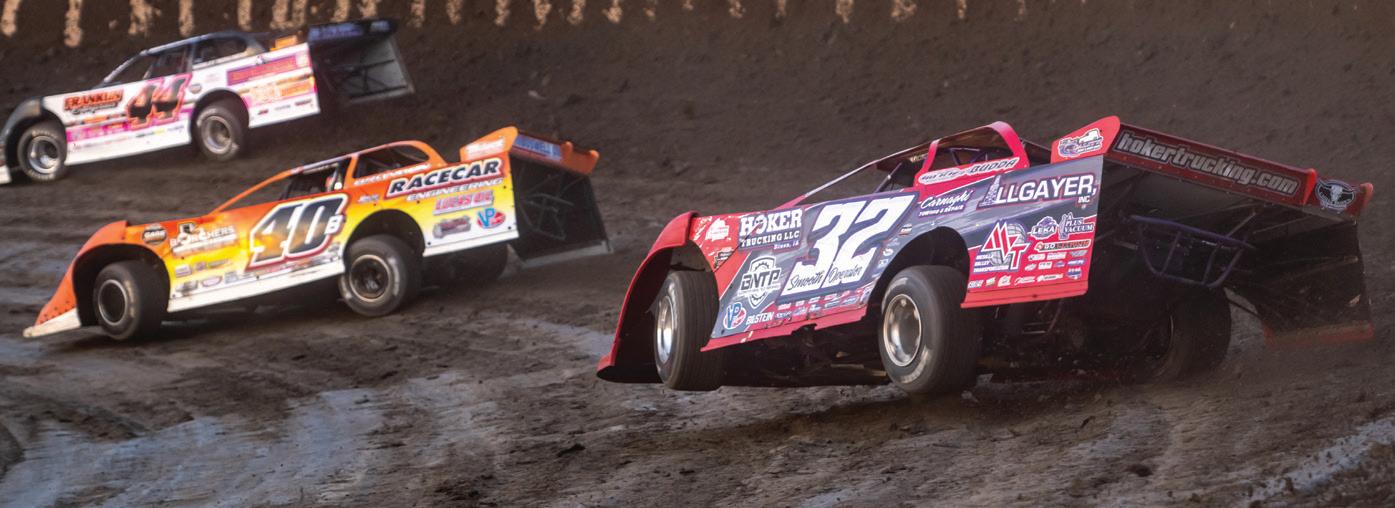 Photo: Michael Moats
Photo: Rich LaBrier
Photo: Michael Moats
Photo: Rich LaBrier
when a receiver catches the ball, and his foot may or may not have been over for a touchdown and it has to be reviewed, there has to be a lot to over turn the call, right? When I came around turn two, and saw my number on the board, that’s when I started celebrating. I knew it was awfully close, and you know, Hudson didn’t complain one bit either, he took it really well.
DE: Aside from winning races, where do you feel your team has really excelled this year?
BP: I would say as a whole team, finding our roles in the team and really doing them well. The consistency is key. It’s extremely hard to go win just one race, there are so many variables throughout the night, and you always have to have a little bit of luck on your side, but you really have to hit your marks every single lap. With the tough competition these days, you really can’t miss anything in your setup. Our versatility has been really good, too, whether the track has been slick or tacky, we’ve won races on every single condition this year against some of the best of the best. We all have our roles. Outside of me driving the car, I work on the bodies. We have a new crew
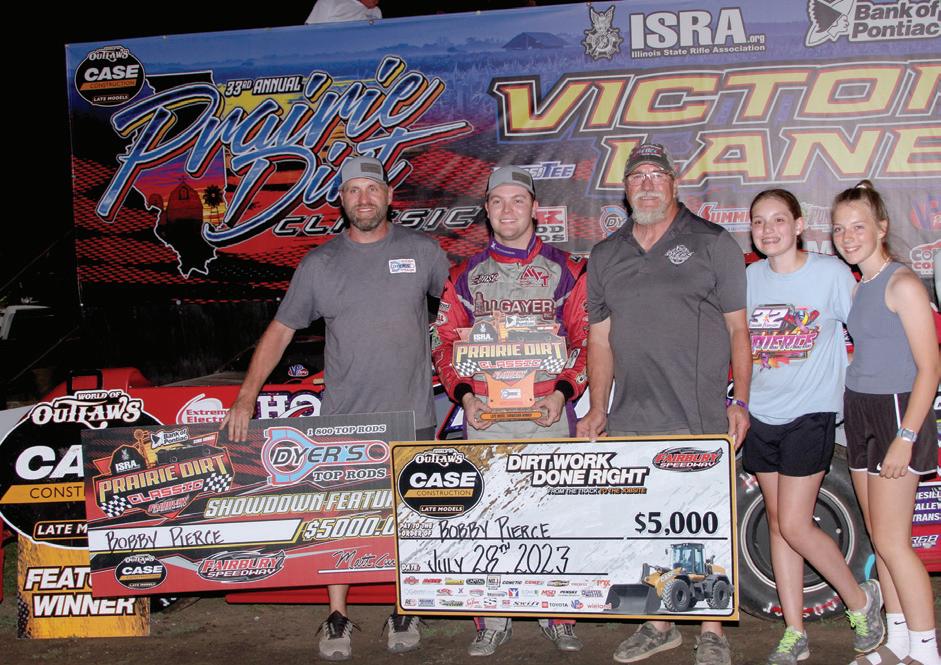
guy Austin doing tires, and I’ve told him precisely down to exact detail how I want them cut, I’ve worked on that for years, so I feel we have a really good handle on that. Then Zach, who has been with me all year, he’s doing a heck of a job, he drives the rig most of the time, he maintenances the car, washes the car,
throughout the night at the track, if there’s something we want him to change on the car he does it quick. My dad, of course, has been doing this forever, and is really smart with it, even though with some of the new stuff today, we’ve had to learn together, but he does really well with the setup and how we communicate



with each other. We have very good chemistry as a team, and we’ve excelled at that.
DE: One last question, and it might be a little loaded, but we love to dive deep. What’s an opinion race fans have about Bobby Pierce that you’d love to change?
BP: I don’t know, I mean, I kinda like them to have their opinions, it creates good drama. If I didn’t have a lot of people who liked me, I might feel a different way. Either like me or hate me, I feel like we’ve gained a ton of fans this year. [he laughs] But no, probably, just that I’m a normal person. I think a lot of people probably assume because of my

dad, that I’ve had a lot of things given to me, and I have, my dad’s worked very hard to be able to do that when I first started out racing. But he’ll say just as much as anyone, that I’ve worked harder than a lot of guys, that I want it bad. I’m out here busting my butt with my guys. I own the team, I’m not someone who shows up to the track with my helmet
Photo: Rich LaBrier Pierce sported a creative Scooby-Doo wrap in late 2021 that was a real crowd pleaser. “That Meddling Kid” was the subject of our Issue 7 cover (still available on dirtempiremagazine.com!)
bag and drives the car, I’m hands on, on everything. You win races in the shop. I think a lot of the success we’ve had this year is because we’re all hands on everything. I say that because that’s probably one of the things people assume the most. There are a lot of drivers who show up to the track to drive, and that’s
fine. I like to be involved and know exactly what’s going on. I know from being in this for so long, that the little details are what can win or lose you races. At the end of the day, I’m super aggressive on the track, because I just want it that bad, but outside of the car, I’m really chill.
YOU WIN RACES IN THE SHOP. I THINK A LOT OF THE SUCCESS WE’VE HAD THIS YEAR IS BECAUSE WE’RE ALL HANDS ON EVERYTHING.
- BOBBY PIERCE



THE OLD SAYING GOES that winning the first one is the hardest and Kyle Larson has proven that to be true with an incredible run in Knoxville. Since scoring the “One and Only” during the 2020 COVID season, Larson has won a Nationals in 2021, ran second to Donny Schatz in 2022 and now swept to his second title in 2023. Larson joined Schatz as the only two drivers to ever lead all 50 laps of the championship race since it went to 50-laps for the 50th edition in 2011.
Larson was challenged throughout by Carson Macedo, fellow front row starter Rico Abreu and eventually by 22nd starting David Gravel, who was the show for anyone not watching the front of the field. Gravel eventually got to second but couldn’t complete the charge. He did best Donny Schatz for the second step on the podium.
As victor, Larson said “To win another Knoxville Nationals feels amazing. When you have guys like Donny, Rico and Gravel coming from the back breathing down your neck, it’s definitely nerve-wracking. I feel like I ran about as good a race as I could. I kept my eyes open for crumbs in the middle. It started latching a little rubber there with 15 or 17 to go. It was helping me on entry. It all just worked out. This is my favorite week of the year. I look
forward to this event all year long. It’s all I think about all week. I’m glad we could get this black and blue car to victory lane for (Paul Silva). He’s the greatest at what he does.”
Larson’s resume is already legendary but every Crown Jewel he captures elevates his legacy to another level. This week in Knoxville, he proved that for this era, he’s the man to beat.


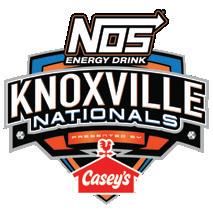
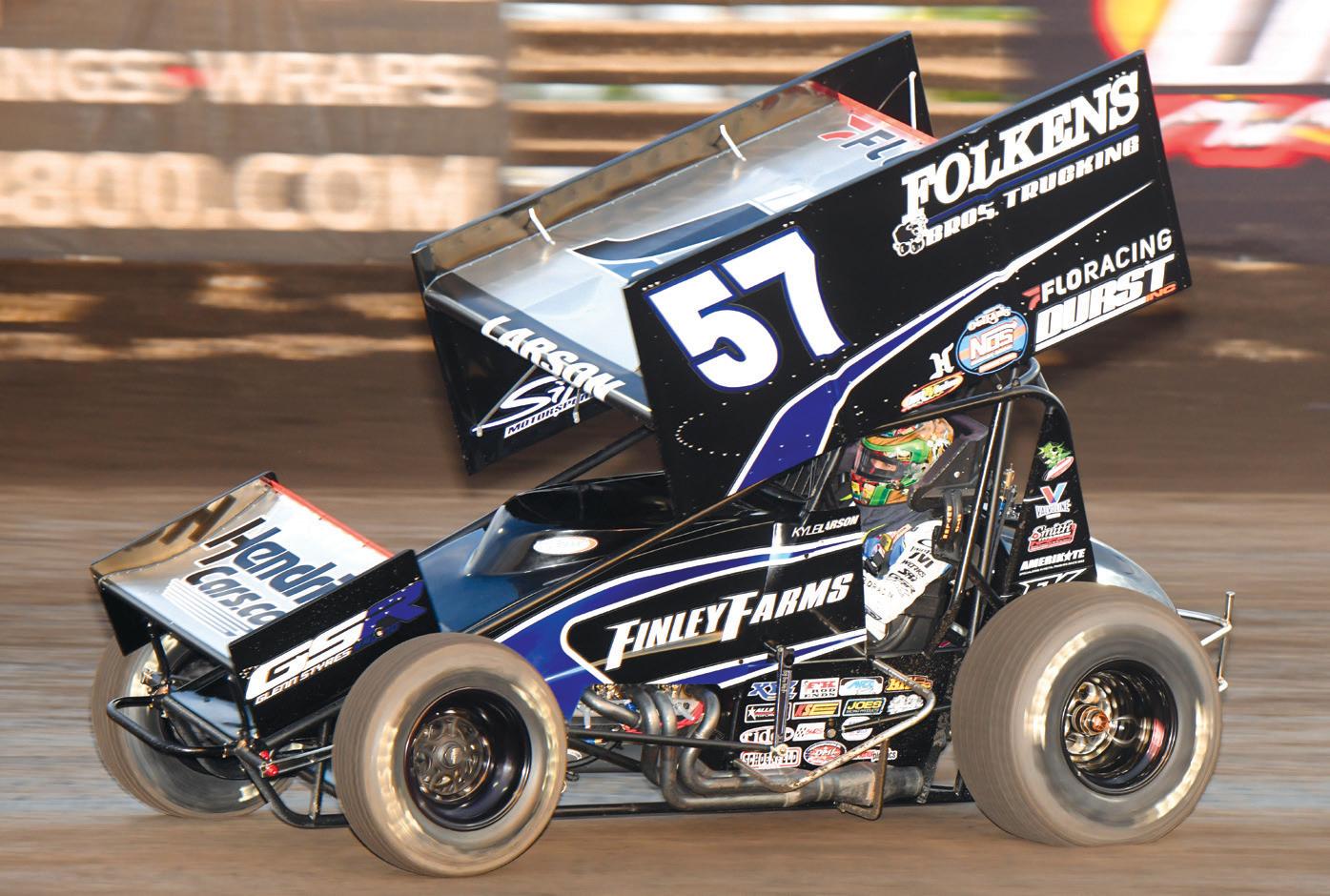


1. Kyle Larson, Elk Grove, CA (1)
2. David Gravel, Watertown, CT (22)
3. Donny Schatz, Fargo, ND (3)
4. Gio Scelzi, Fresno, CA (9)
5. Carson Macedo, Lemoore, CA (5)
6. Brad Sweet, Grass Valley, CA (16)
7. Rico Abreu, St. Helena, CA (2)
8. Buddy Kofoid, Penngrove, CA (8)
9. Kerry Madsen, St. Mary’s, NSW, Aust. (7)
10. Sheldon Haudenschild, Wooster, OH (20)
11. Spencer Bayston, Lebanon, IN (13)
12. Corey Day, Clovis, CA (10)
13. Chase Randall, Waco, TX (14)
14. Brian Brown, Grain Valley, MO (19)
15. Ian Madsen, St. Mary’s, NSW, Aust. (11)
16. Aaron Reutzel, Clute, TX (21)
17. Dusty Zomer, Sioux Falls, SD (12)
18. Parker Price-Miller, Kokomo, IN (18)
19. Justin Peck, Monrovia, IN (17)
20. Anthony Macri, Dillsburg, PA (15)
21. Davey Heskin, St. Michael, MN (24)
22. Scott Bogucki, McLaren Vale, SA, Aust. (23)
23. Logan Schuchart, Hanover, PA (4)
24. Hunter Schuerenberg, Sikeston, MO (6)
Photo: Ashley Zimmerman Photo: Paul Arch
 Photo: Nicole Signor
Photo: Nicole Signor
The front four for the Friday night Hard Knox finale featured Aaron Reutzel (8), Brandon Wimmer (7TW), Jamie Ball (4) and Scott Bogucki (10). Only Reutzel and Bogucki stayed in the top four to punch their ticket to Saturday’s main.
Photo: Nicole Signor
Photo: Nicole Signor
The front four for the Friday night Hard Knox finale featured Aaron Reutzel (8), Brandon Wimmer (7TW), Jamie Ball (4) and Scott Bogucki (10). Only Reutzel and Bogucki stayed in the top four to punch their ticket to Saturday’s main.

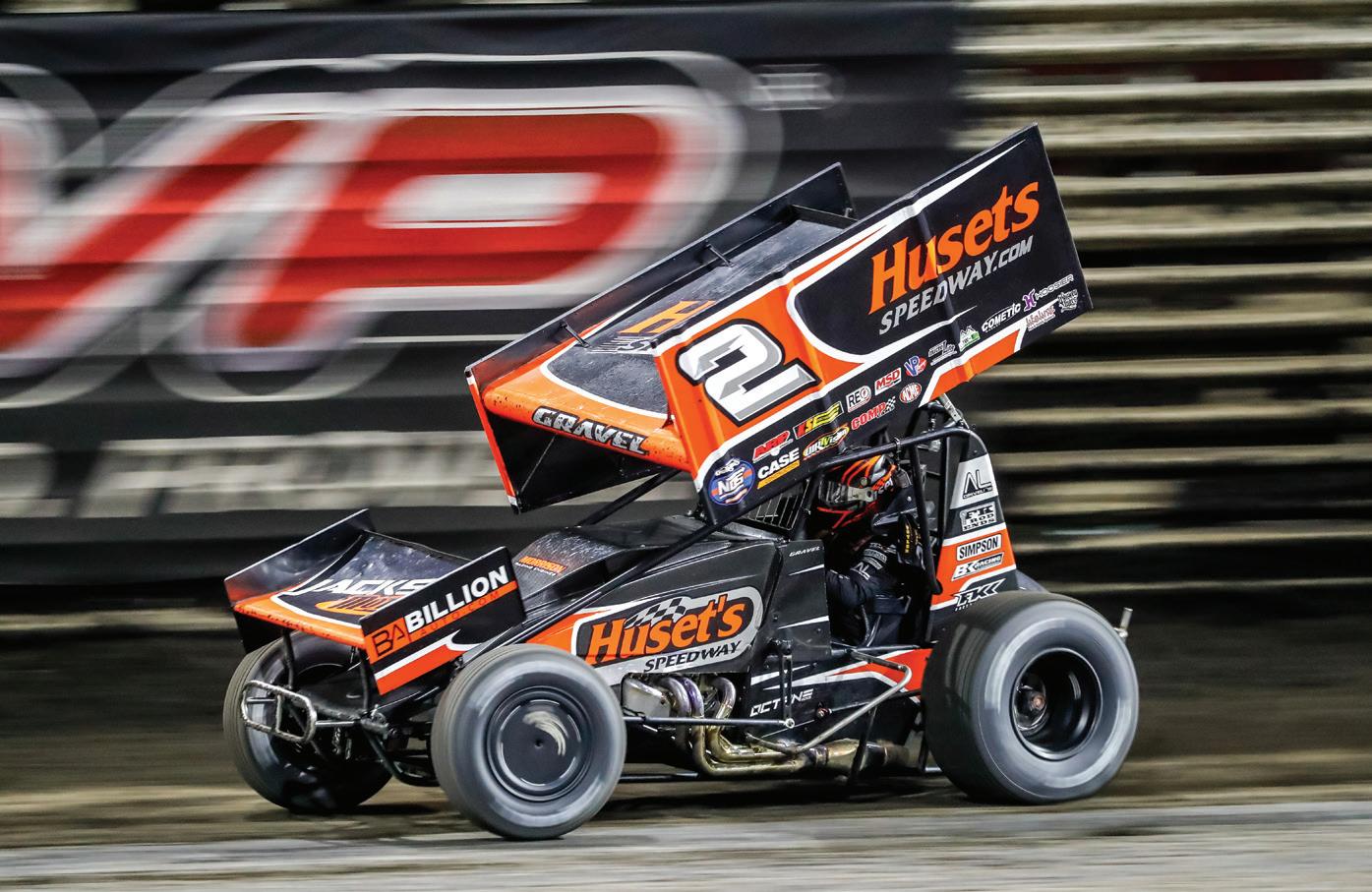
 Photo: Brandon Anderson
Photo: Brandon Anderson
Photo: Brandon Anderson
Photo: Brandon Anderson


 Photo: Paul Arch
Photo: Mark Funderburk
The Knoxville Nationals are always an international affair and three countries were again represented in 2023. Brooke Tatnell (16) represented Australia, Tim Kaeding (3) flew the Stars and Stripes while Robbie Price (7s) hailed “Oh, Canada”.
Photo: Paul Arch
Photo: Mark Funderburk
The Knoxville Nationals are always an international affair and three countries were again represented in 2023. Brooke Tatnell (16) represented Australia, Tim Kaeding (3) flew the Stars and Stripes while Robbie Price (7s) hailed “Oh, Canada”.



 Photo: Brandon Anderson
Car owner Paul Silva went with a throwback scheme for the Knoxville Nationals that harkened back 20 years to the beginning of his family run team and Kyle Larson had the 100+ car field chasing that black tail tank all week.
Photo: Brandon Anderson
Car owner Paul Silva went with a throwback scheme for the Knoxville Nationals that harkened back 20 years to the beginning of his family run team and Kyle Larson had the 100+ car field chasing that black tail tank all week.


Finally, the Knapp Family put up some money for the Best Appearing Helmet and Carson McCarl took it seriously and had this beauty (below) celebrating the McCarl family legacy as well as the Dollansky family for his wife Peyton, daughter



 Christopher Thram (above) enjoyed his first Knoxville Nationals on his Burromax pit bike, while the hottest reading material in the pit area was Dirt Empire, of course. RoY contender Kelby Watt (right) enjoyed his copy of the best dirt track racing magazine in the world.
of Craig Dollansky.
Photo: Ashley Zimmerman
Photo: Ashley Zimmerman
Christopher Thram (above) enjoyed his first Knoxville Nationals on his Burromax pit bike, while the hottest reading material in the pit area was Dirt Empire, of course. RoY contender Kelby Watt (right) enjoyed his copy of the best dirt track racing magazine in the world.
of Craig Dollansky.
Photo: Ashley Zimmerman
Photo: Ashley Zimmerman

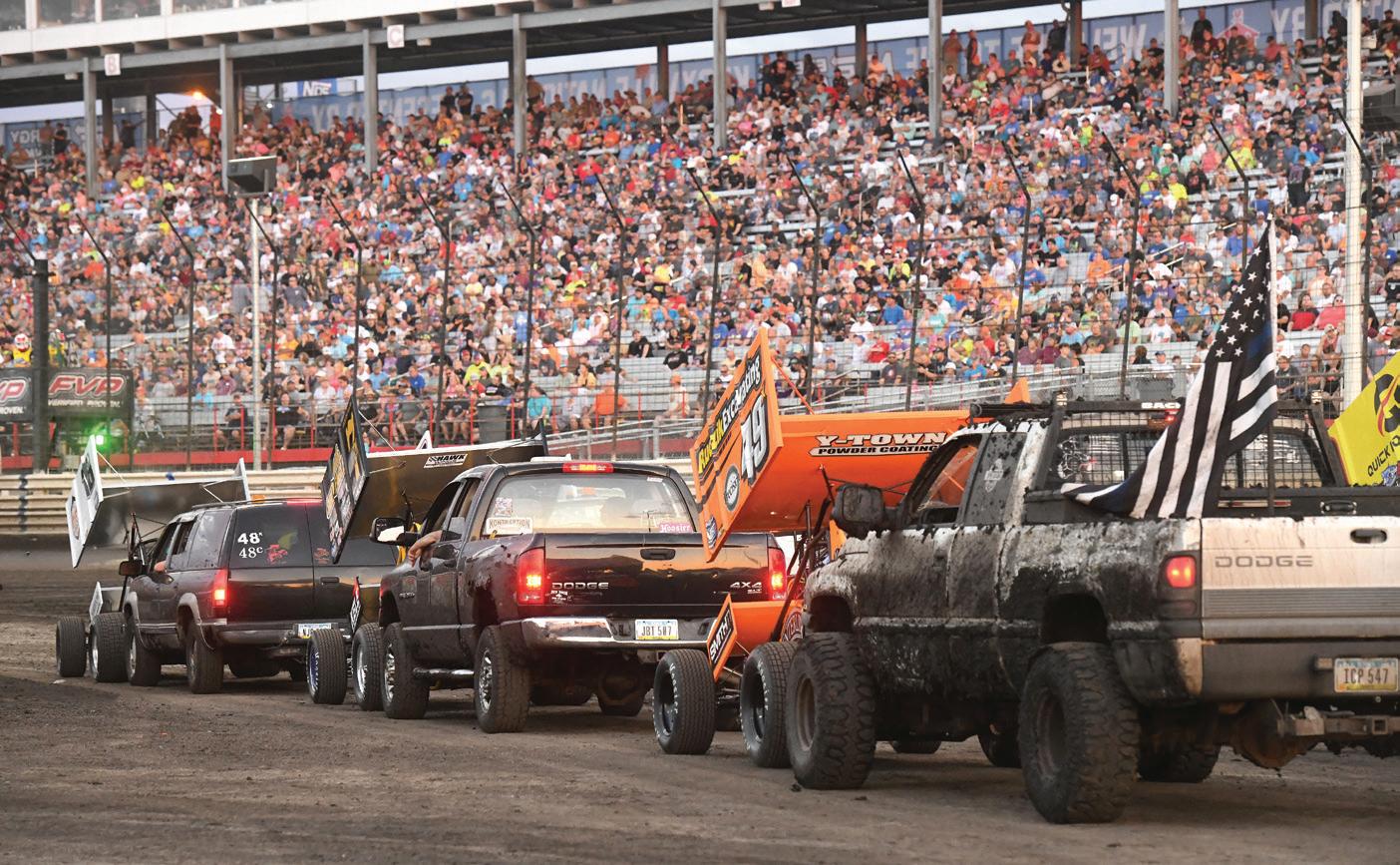 BY LARRY WEEKS
BY LARRY WEEKS
A WHOLE LOT of things add up to make the Knoxville Raceway and Nationals the incredibly special event that it is. The huge grandstands, the reliable track prep by the Dunkin family, the black gumbo dirt itself, the paved infield, and the feeling of family that exists among strangers in the grandstands and all over the whole town during the ten days of racing.
There’s another family that most fans never notice or notice but don’t really think about. That’s the family of push trucks and 4-wheelers that keep the show moving. They are a proud bunch. There are official Push Truck t-shirts and many of the trucks sport vinyl “Knoxville Push Truck” stickers in the back window. Not only are they a “race” family, there are multiple actual families involved. Both the Worthingtons and Jones bring three generations to every race.
“Some start right off, others take a little longer. You have to feel it to know when to back off,” said Justin Worthington, one of the 30 or so push truck drivers and the third generation of Worthingtons working together at Knoxville. Grandpa Jim started in 1979 or 1980 and, at 78 years old, is
still pushing today. Justin’s dad, Greg and his Uncle Doug also push. They aren’t the only 3-generation family. Dave Jones, his son Mark, and Mark’s son, Alix, all bring a truck to every race. Dave’s brother, Jerry, is also a member of the crew.
While most sprint car events struggle with just a few trucks to push-start the cars, Knoxville has one for each car, plus spares! Where’d this luxury come from? That’s a tough question to answer. Did someone develop a plan, set up procedures, recruit trucks and drivers? If so, that plan has been lost to time.
There’s a group of old-timers that gather behind the infield concession stand to bench race and hide from the brutal, Iowa, August sun. One of them is 91 year old, Bob De Moss. Bob started pushing the supermodified coupes back in 1954 with the first weekly racing program. “We had 10 to 12 trucks even then. By the first Nationals in 1961, we had a few more, you might have to push more than one car for the feature.” When we started talking I asked him how it started, he just said, “We knew they needed trucks so we showed up.”
Another long timer is Randy Rowley, who started in 1975. He pushed for five years, became one of the officials, retired from that after 36 years and went back to pushing race cars. “Jim Roush was
the one who organized the push trucks and his son Bob is now the Fair Board President. I was head of the trucks for a while and I always had a huge list.”
The current boss, Greg McDonald, believes that a big reason for all the trucks, is just “…the prestige of being here. It’s a big commitment, it’s every Saturday and more. Last Sunday, for the Cappy they called me at 12:30. I sent out a multi-text and in half an hour 20 trucks were here to help run in the infield.”
The quality of the Knoxville Push Trucks is earned and recognized in the area. McDonald continued, “We get called to help at several tracks in the area. Terry (McCarl) uses us for his race at Osky, we go up to Jackson and down to Missouri.”
Since Randy Rowley mentioned Jim Roush being involved early, I went looking for his son, Bob. I found him inside turn three, making sure everyone got paid for the night. “We raised the pay a couple of years ago and should probably talk about raising it for next year since gas keeps going up. If they work extra, like last Sunday (for the “Cappy”) we give them another night’s pay. I remember one day they were all starting to run out of gas so we had them go over to Casey’s and put in a tank of gas on the county account.” Besides the pay, each driver gets in free and can bring one guest.


The smooth-running show isn’t guaranteed by just the trucks. “My uncle, David Cornwell, was driving a push truck and using his 4-wheeler for hunting and other things. He thought the 4-wheeler just might work to get behind the race cars a little easier. One night, around 1989, he brought it and it worked,” Ron Bougher told me. Ron now heads the 4-wheeler crew and the track supplies
them. “There are six of us. We get in free and get paid a little.” Watching them work with the trucks is like watching a big gasoline-fueled ballet.
Everyone knows their job. When a car rolls back from its stall, within seconds a 4-wheeler picks it up and delivers it to the push-off area. A push truck appears to replace the 4-wheeler behind the car and grunts, slightly, as it overcomes


the resistance of the high-compression engine and accelerates the sprint car to 20+ mph as it fires.
Next time you watch a feature push off at Knoxville, say a thank you to the fleet of push trucks and 4-wheelers that keep the show moving and make Knoxville the success that it is.

 A family affair: two families, three generations each. From left to right: Jim Worthington, Jim’s son, Greg, another son Doug, and Greg’s son Justin. Next is Dave Jones, his son Mark, Mark’s son, Alix, and Dave’s brother Jerry.
Photo: Larry Weeks
The Knoxville 4-wheeler crew, headed by Ron Bougher, wearing the yellow helmet.
Photo: Larry Weeks
A family affair: two families, three generations each. From left to right: Jim Worthington, Jim’s son, Greg, another son Doug, and Greg’s son Justin. Next is Dave Jones, his son Mark, Mark’s son, Alix, and Dave’s brother Jerry.
Photo: Larry Weeks
The Knoxville 4-wheeler crew, headed by Ron Bougher, wearing the yellow helmet.
Photo: Larry Weeks

SINCE BEGINNING his racing career
25 years ago, late model driver Jeremy Wonderling has done nothing but get better and better and better. Prior to getting into a crate late model in 2014, Jeremy raced an IMCA modified, a 360 late model, and competed in the BRP Series. According to series officials, Wonderling is the all-time leader in feature wins in that series. From 2001 through 2013, he captured three titles, one at Little Valley and two more at Black Rock.
The Wonderlings are certainly a racing family with dad, Mike, competing in a late model back in the 1980s through 2014. The boys, Mike, Brady, and Jeremy all race. Mike, the eldest of the three lives right next door to his younger brother, Jeremy, so sharing racing information is no more than one door away. His parents, Mike and Deborah, live on the other side
of Jeremy. Jeremy talks about a race at Bradford this past season when he won, with Brady and Mikey in tow in second and third place. That happened one other time, at Woodhull in 2009.
All three Wonderlings are loggers by trade. Jeremy and Brady are the loggers, while Mikey does the hauling. They subcontract for their uncle, Charlie, who is the owner of Baldwin Forest Products.
Mikey has won track titles at Outlaw Speedway in a 360 Late Model in 2010 and the BRP championship in 2014. Both Mikey and Brady joined up with the RUSH Late Models in 2015.
For the most part, Jeremy and Brady have been racing side-by-side for a number of years while Mikey moved on to racing a super late model, with occasional stops for a RUSH Crate Late Model race. In 2023, the Wonderlings have been dominant in the series with Jeremy leading Mike at the top of the standings. There were a number of years when dad, Mike, and his three boys were able
to compete against each other on the track. He remembers when he was racing against his dad, something that was very special for Jeremy. “I remember a lot of times when we went side-by-side,” said Jeremy. “He cared more about what we were doing than what he was doing.”
“I remember a BRP race at McKean when I was running second to him for 28 laps and then passed him with two laps to go,” said Mikey. “Being able to race against him for 15 years was certainly the highlight of my career,” said Brady.
“When I was younger, I was dad’s crew chief,” said Jeremy. “He’s influenced all of us. He’s probably the best I’ve ever seen. He was so smooth. There were things he did in a racecar that I’ve never seen. He was able to come back from the rear of the pack and win races with not the best equipment.”
Originally, Mike retired after the 2007 season, but was talked back into racing by his son, Jeremy. That lasted for another seven years. “He didn’t go out

without a bite,” said Jeremy. “In his last season, he won the Freedom Speedway championship and seven features.”
One of Jeremy’s biggest thrills in racing was winning the RUSH Weekly National Series in 2022. “It meant a lot to me,” said Jeremy. “I didn’t win the title until the final weekend. I needed to win both races at Genesee and I didn’t think that would happen.” But it did, as Jeremy won those races and won the title beating out Jason Genco by a mere four points. He also finished third in the RUSH Touring Series with brother, Brady, in fourth.
Overall, Jeremy says he’s won ten or so championships, including a pair with the 360s. Through the 2017 season, Jeremy pretty much raced locally winning 10 or better races a season. It wasn’t until 2018, the year that Jeremy joined the RUSH Touring Series full-time. He was able to win a handful of features that year which was enough to win the championship. As for the RUSH Series overall, Jeremy said, “With everything that Vicki (Emig) does and the pay is great-its just huge up in this area. The teching, the purses, and the point funds are all great.”
And what about the brothers racing against each other? Mikey, who is 49 said, “For the most part it’s pretty cool. We race each other like we would against anyone else, but the one thing that we’re all out there for is to win. For the most part it works out okay, but we certainly have had our nights. Of the three of us, Jeremy is definitely the most aggressive. I would describe my driving style as being calculated.”
At 47, Brady said, “I guess that’s what keeps me racing. Without them I probably wouldn’t be racing at all. You want to beat
 Photo: Zach Yost
Photo: Zach Yost
them as much as anyone else, but if I can’t beat them, I want them to win. All three of us had our battles where each other didn’t feel the other one did the right thing. But two days later we’re back at the race shop sharing information. It really depends on track positions. There’s a place to be aggressive and a time to be patient. You drive the track the way it should be driven. There are times when you can’t be aggressive because of the track. The conditions will dictate how you race. I’m more conservative as a driver while Jeremy is a little more aggressive. Mikey and I are a little more passive. However, being aggressive probably makes you win more races.”
The youngest at 42, Jeremy said, “At times it’s pretty good and at other times, not so good. But I have a lot of fun doing it. We don’t race each other any different whether it’s for points or not.”
Jeremy added, “If the cars are working right then we all are aggressive. Both Mikey and Brady are patient with Mikey being consistent and Brady smooth. But when they have to put the pedal to the metal, they have no problem becoming more aggressive.”
Wonderling believes the main reason he started to turn his career around as early as 2011 was to align himself with good people and good help. “That’s when I hooked up with Close Racing Supplies and Joel Smith. That was the beginning when my career started to take off. He (Joel) provides me not only with the parts I need at the racetrack, but with his knowledge as well.”
His second big hookup came in 2019 when Jeremy switched to a Longhorn Chassis and befriended a guy from Penske Shocks by the name of Jim

Stevens. “He helped my career as much as anyone.”
In 2021, Jeremy finished second in points and then sold that car at the end of the season. He used his second Longhorn for the better part of 2022 before buying a second one from Eric Wells Motorsports. Jeremy went onto win eight of ten races in the new Longhorn, including four Touring races.
Jeremy says that his back-to-back wins at Genesee that secured his championship was the beginning of a very productive two-week streak. After those pair of wins at Genesee, Jeremy went to Tyler County for the Hillbilly Weekend. On Thursday of that week, he won the Cider Jug 40. One night later, he travelled to Pittsburgh and won the $10,000 to win first place prize at PPMS. That gave him
$20,000 over a seven- day span. “The win at Pittsburgh was the biggest payout I have ever won in my career.”
“I’m really excited about the upcoming season because of those last ten races of 2022,” said Jeremy. “It will be the same car with the same shock package.”
His parents follow the boys’ racing schedule by driving their mobile home to the different tracks that the boys compete.
Jeremy and his wife, Abigail have a teenage son, Carson, who is also getting into racing. His dad bought him a Sharp Mini Late Model that Carson raced for the first time last season. “He didn’t do too badly,” said Jeremy. “I help him with his racing program and we are excited for the upcoming season.”
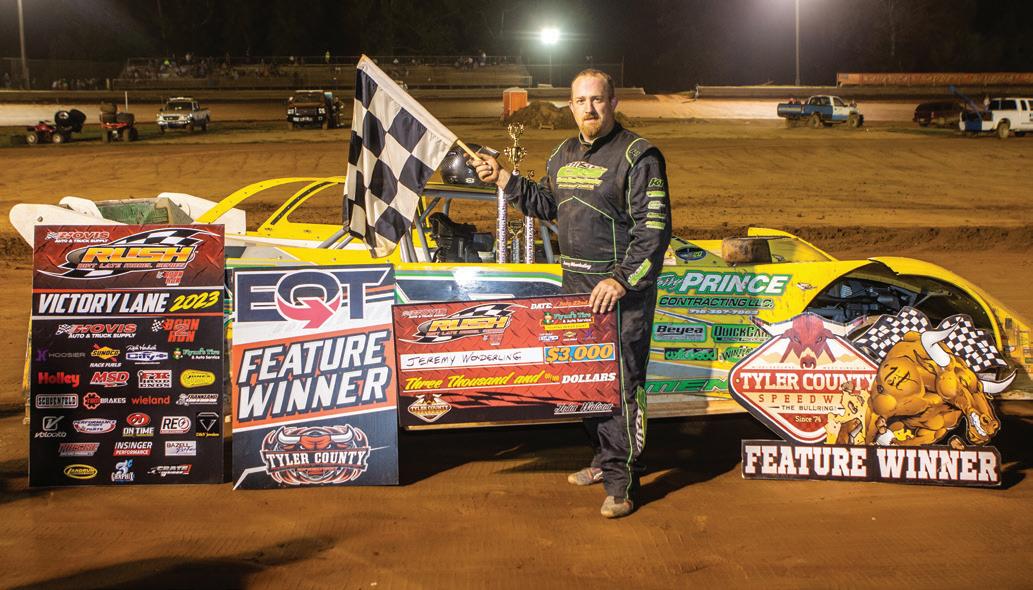
Close Racing Supply, Shuttlesworth Auto Sales, Cummings Trucking, Swift Springs, Dynamic Drivelines, Wehrs
Manufacturing, All-Star Performance Parts, Terry Prince Contracting.
Photo: Paul Arch Photo: Zach Yost


IN A SEASON full of statement wins, Bobby Pierce added another Crown Jewel and padded his pockets with a sterling victory in the USA Nationals at Cedar Lake Speedway. It didn’t come easy as Pierce had to hold off Hudson O’Neal in the final in what has become a season-defining rivalry between Pierce and O’Neal. The win was worth $50,000 for Pierce and gave him redemption after getting close nearly a decade ago in Wisconsin.
“I’ve always wanted to lead laps in this race towards the end,” Pierce said. “We were always getting there too late. I’ve finished with a lot of top fives and top tens in this race. It was a long time coming here, and if I had the experience I had back in 2014, I probably could’ve beaten Jimmy (Owens). I kind of gave that race away to him. I never knew if I’d ever get that opportunity again. And here it was.”
Pierce and O’Neal were joined by Tanner English on the final podium while Dennis Erb Jr. and Brandon Sheppard also scored top-five finishes.
 PHOTOS BY TODD BOYD
PHOTOS BY TODD BOYD
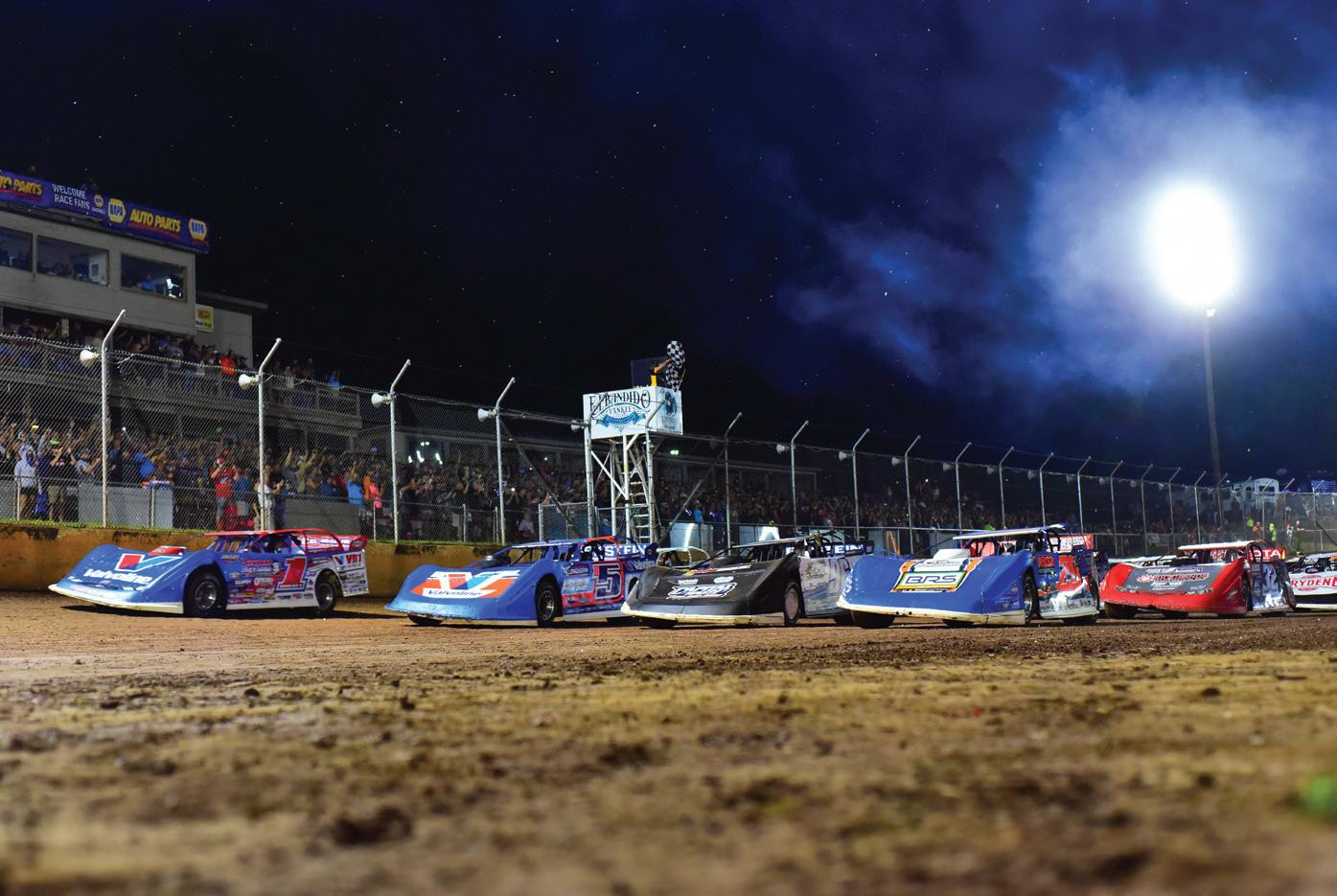


Cedar Lake Speedway always packs the house and commits to pageantry throughout the event that featured lots of great racing action throughout three nights of action. In the middle shot, competitors the likes of Daulton Wilson (18D), Jonathan Davenport (49), Tyler Erb (1) and Nick Hoffman (9) were all held out of the top five in the Saturday night finale.
Brandon Sheppard sneaks by polesitter Ricky Thornton Jr., who had an off night and scored a DNF in the feature.
Jake Timm, in the 49, was a B-main transfer but is about to go a lap down to Bobby ‘Blistering Pace’ Pierce during the 100-lap finale.


Its early in the main event and Bobby Pierce is working the top in his red #32 while Tanner English (96V), Brian Shirley (3S) and Dennis Erb Jr. (28) try different lines to keep up with him.
He got one - Pierce finally closes the deal at Cedar Lake, celebrating with family and a miniature Case Construction earth mover.

FAST: We exist to improve your racing program in every way. We provide FAST service and products to help make your racecar FASTER!
OPTIONS: We are able to offer you a vast amount of OPTIONS to best address your needs by working with many of the best shock brands in the industry.
CUSTOM: We provide solutions for your racecar that are CUSTOM tailored to you and your racecars’ specific needs and goals.
UNIQUE: We are able to tune your entire suspension package with UNIQUE options (bump stops, bump springs, dual stage and stacked springs) with our Accu-Force Spring Smasher.
SERVICE: We provide real brand shocks utilizing our in-house Roehrig Dynamometer.








IT WAS A RAGS TO RICHES story ten years in the making. Logan Schuchart and Shark Racing scored the Eldora Million - the richest sprint car race in historyas a family teamed helmed by Logan’s grandfather Bobby Allen. A perennial underdog during his own career, Allen’s grandson scoring the race was the ultimate vindication that hard work pays off.
However, it would be foolish to say that Schuchart was an underdog this time. Shark Racing has built themselves into one of the premiere teams in the sport and Schuchart had been knocking on the door at nearly every big race in the country prior to winning the Million. “This team has
Pos. No. Driver
1 1S Logan Schuchart
2 41 Carson Macedo
3 49 Brad Sweet
4 2 David Gravel
5 24 Rico Abreu
6 21 Brian Brown
7 83JR Michael Kofoid
8 15 Donny Schatz
9 13 Justin Peck
10 83 James McFadden
11 19 Brent Marks
12 19L C.J. Leary
13 11 Cory Eliason
14 7BC Tyler Courtney
15 1A Jacob Allen
16 67 Justin Whittall
17 91 Kyle Reinhardt
18 55P Daryn Pittman
19 8 Aaron Reutzel
20 57 Kyle Larson
21 5 Spencer Bayston
22 18 Giovanni Scelzi
23 25 Lachlan McHugh
24 22 Cole Duncan
come such a long way and I know I say it time and time again, but I hope any kid or person in general can know what I’m feeling right now, to win a race like this,” Schuchart said. “If anybody ever tells you you can’t do anything, I know you hear that a lot. There’s lots of nights I sat there thinking, should I do something else? I don’t know if I’m good enough for this. I ran second in every major event and what if I never win one of these big races?”
Schuchart answered the critics and the voice inside his head and Eldora Speedway answered the fans and gave them what they had always wanted - a sprint car race worth $1,000,000.



 Photo: Paul Arch
Photo: Tyler Carr
Photo: Paul Arch
Photo: Tyler Carr

BOBBY “GUNTHER” WALSH began his racing career at Grandview Speedway in Bechtelsville, Pennsylvania, back in 1995, a track appropriately named with its panoramic view of the nearby Upper Perkiomen Valley area. His father, Joe, who is now 91-years-old, raced stock cars back in the 1960s at the now-defunct Lake Moc-A-Tec Speedway in Lakeville, Pennsylvania, as “Gunther” ultimately, got into several small radio jobs to start a career. “Gunther” got a phone call one day in the early 1980s from a former employer to host a radio program and later was offered a part-time gig on the local “Dialing for Dollars” television show in Scranton, Pennsylvania.
His first love was radio work and WAEB 790AM in Allentown approached him in 1983, but he declined the offer to take over the morning show. The station offered again in 1984 and “Gunther” agreed. It was earlier in the late seventies
when a local high school teacher thought Walsh looked like a “Gunther” and, later, when a station manager overheard a conversation he urged Walsh to use the nickname on the air. That became his onair moniker and he still uses it today, still with WAEB as the morning drive host for some 40 years.
Walsh, 64, from New Tripoli, Pennsylvania, these days, made a pact with his older brother, Joe, now 70-yearsold, never drink coffee, smoke cigarettes or drink alcohol, mainly because it brought back childhood memories.
It was around 1994 when Walsh changed direction in his life, putting him where he is today.
“I got divorced and I didn’t smoke or drink, but I needed something to look forward to,” submitted Walsh. “On a whim I said on the radio I had an interest in driving a 358 modified car. When the show ended my producer told me there was someone on hold waiting an hour to talk with me. I picked up the phone and was told I had a ride if I was seriously
interested. I got connected with Ray Swinehart and he was willing to rent me a car. My listeners thought it was a radio publicity stunt, but it wasn’t. I was serious. I wanted to be a driver. I had no idea what the competition was like at Grandview and really had no idea what I was getting myself into.”
First Walsh rented a race car from Swinehart, later he leased a car from Mike Kelly and also had Keith Hoffman hired as his weekly maintenance man, if you will. Eventually, Walsh became the owner and driver with his own operation. He branched out to weekly racing at Big Diamond Speedway Friday nights and, later, tried racing at Penn Can Speedway weekly on Friday nights. Grandview, though, remained every Saturday since he first climbed aboard a 358 modified ride and, today, the high-banked third-mile clay covered oval on the hill is his racing home weekly.
“Race cars don’t run on racing gasoline,” Walsh explained. “They run on money. I’ve always treated my racing as
Photo: Scott Bender
a business. I do whatever I can to stay in the black. My sponsors want to hear their cash registers ring.”
Walsh had racers listening to his radio show and listeners came to watch him at the races. Sponsors advertised on his radio show and show advertisers helped sponsor the racing efforts. Walsh promotes his supporters at the track and hands out products and samples to fans after the races at the trailer. Everything intermingles between racing and radio.
Walsh weekly has his dad in the grandstands watching his son race at Grandview and his older brother helps out in the pits with the car as much as he can. “I know I’ve brought a lot of radio fans to the race track,” Walsh commented. “My dad used to race and I thought I’d like to give it a whirl. When I first got started it was like a lot of people had an idea who I was but they really didn’t know. Some listened, but never went to the races and a lot of others went to the races, but seldom listened. Now, I’d say, a good portion of the people at the races listen to the show and many who listened became race fans.
“Racing allows me to take my mind off the high pressure that a radio job brings and sure there is pressure in the race car, but it’s different than a job. I enjoy doing it. It’s fun. It’s a hobby and I meet a lot of good people along the way,” suggested Walsh, the father of one daughter.
Walsh also does a lot of radio broadcasts supporting many local businesses and charities, also
giving the track lots of great exposure as well. He’s raised money for the Keystone Warriors (Pennsylvania Wounded Warriors) and Children’s Home (homeless and abused and abandoned children) and the Allentown Rescue Mission (for the homeless families), plus there’s Animals in Distress and the Leukemia and Lymphoma Society and so many others.
When it comes to racing, Walsh figured it took him, maybe, five full racing seasons before he felt comfortable and he felt like he knew what he was doing in the race car. With nearly three decades in that race car, with the 2023 season being his 22nd as a car owner and driver,
Sponsors advertised on his radio show and show advertisers helped sponsor the racing efforts. Walsh promotes his supporters at the track and hands out products and samples to fans after the races at the trailer. Everything intermingles between racing and radio.
there’s so much that keeps him going. It’s fun. There are the thrills and the rush of the speed and the weekly challenge. His biggest challenge is still earning that first real Grandview feature win. Walsh has won heat races and consolations and he’s had some solid finishes, but he’s never ended the night of competition celebrating while standing in victory circle. It today is his biggest goal that keeps him going.
“At Grandview there are numerous veterans and drivers who’ve won a dozen championships, plus guys with the big sponsorship deals and to get beat by them, you still feel like you won,” offered Walsh. “When you beat out those others who have my equal abilities you take some consolation in that. It wasn’t like you got beat out by a slacker at the checkered. You wish you won, sure, but you lost to the best out there and those guys are expected to beat you. Grandview is one of the toughest places around to be successful at.”
Like the cherry on top of an ice cream sundae, Walsh has no real time table figured out as to when he might wrap
 Photo: Michael Moats
Photo: Scott Bender
Photo: Michael Moats
Photo: Scott Bender
up his racing career. As long as racing remains fun and Walsh is doing well, happy with the results, he might keep things going for several years. There is no light at the end of the tunnel, just yet.
“As long as I am doing well by my standards,” offered Walsh. “I know I’ll never be a Craig Von Dohren or Jeff Strunk or Duane Howard or Brett Kressley, but going by my standards, I’m having fun, I still enjoy doing it and everything that is involved. Racing and doing well still gives you that rush. It makes me want to keep going. I’m really enjoying it.
“I have drivers come up to me and tell me they enjoyed what I had to say on my radio show and that shows they’re listening, which is great. Drivers want to talk politics or something I mentioned on my show and that has me excited about the fact they are listening. We had a good year, I thought, in 2022 and I enjoy promoting my sponsors. I help to promote the track, the radio station and my sponsors and everyone enjoys the cash register ringing in the end. I love the fans that stop by the car after the races, the race track and the Rogers family who promote the race track. I enjoy it. It is a lot of work. We have the website and t-shirts

and giveaways to fans after the races and everything builds up those friendships that have lasted through the years. A lot of the people I’ve got to meet are really good people at heart. I’ve got to meet so many great people who became friends over the years and that’s what it’s all about,” submitted Walsh.
“I like to help market the sponsors so they’ll renew, but racing has also connected me with the fans,” said Walsh.
“I talk with the fans, get to know them and learn about their families and about their life. They all know about me and my family and it creates people rooting and cheering for you in the stands because they now know you. They aren’t there rooting for the car, they’re rooting for the person, a driver they got to know. Dirt racing is like an addiction and it’s an extreme sport. It’s such a thrill. A tremendous experience I enjoy.”


ONE OF OPEN WHEEL racing’s most versatile drivers, Ron Shuman – or the “the Flying Shu” as he was dubbed - started out in motorcycles before switching to four-wheel racing and in 1972 immediately won the Arizona Super Modified championship.
In 1979, he won the most prestigious event in sprint car racing, the Knoxville Nationals which completed his mystical Triple Crown having already won the Western World Sprint Car Championship in 1975 & 1977 (and later in 1981 & 1984) and the Pacific Coast Nationals in 1977 (and later in 1983).
After his Knoxville success, Shuman tried his hand at champ cars and later USAC racing, winning three times in the prestigious USAC Silver Crown Series before became a regular on the World of Outlaws Tour from 1979 thru 1987 winning 14 features against the best in the business.
In 1988, he decided to stay closer to home and started racing with the California Racing Association (CRA) and won the championship four straight years. When the CRA became the SCRA, he added three more championships. He also proved to be a terror in a midget winning the prestigious Turkey Night Grand Prix an amazing eight times between 1979 and 1993.
Shuman was inducted in the National Sprint Car Hall of Fame in 2003 and we

caught up with him recently to check in on his thoughts on his career and his life post-racing.
Dirt Empire: You had a long and distinguished career, what was your proudest moment?
Ron Shuman: Too many to list, but here’s the top ones: Knoxville Nationals, Western World Championship, The Triple Crown, The Hoosier 100.
DE: You raced against all the legends but, to this day. What driver was your toughest competition?
RS: Steve Kinser by far.
DE: What was your scariest moment?
RS: It was definitely in the early 1980s when a lapped car flipped me at Ascot. It barrel-rolled me six to eight times.
DE: Any regrets about your career? Any races you didn’t win that you wished you would have?
RS: Definitely. I have no regrets about races, except maybe the Chili Bowl.
DE: Of all those tracks you raced on, which was your favorite? Which was the one you never wanted to go back to and why?
RS: Ascot was most definitely my favorite.
 Photo: Mike Feltenberger
Photo: Joe Orth
Photo: Mike Feltenberger
Photo: Joe Orth

Winchester Speedway was my least favorite. The infield was raised, and it made it where I couldn’t see across to the backstretch or to the corner we were approaching. I like to be able to see far enough ahead on the track to be competitive and safe.
DE: So, what has Ron Shuman been up to since retiring from racing?
RS: The year after I retired, I was voted President of the SCRA (Southern California Racing Association) and my wife Paula was Secretary. We ran the organization from 1998 to 2004. Paula developed a promotional company, so we arranged a two- week tour in the Midwest called The Non-Wing World Championship. We were voted Promoters of the Year five years in a row. I’ve been selling auto parts ever since we quit the racing tour and running SCRA.
DE: Do you still follow racing?
RS: Yes, absolutely because our son Casey is heavily involved with racing in the Midwest. I also enjoy the NASCAR races, too.
DE: What do you think is the biggest difference between today’s racing and racing back in your heyday?
RS: I think there was more of a family atmosphere at the races back then, especially when we traveled in groups. We definitely had more fun. Steve Kinser, Danny Smith, Bobby Allen, myself and a few others we were a tight group of friends on and off the track.
DE: Any advice you would like to pass on to young drivers?
RS: The golden rule works on the racetrack, too! If you race others the way you want to be raced that creates respect. When drivers respect each other on the track, the race will be safer and way more fun. One of my secrets of racing was I developed a skill of being able to look way, way, way ahead of where I was going. If the younger drivers start training themselves to do this, they will avoid many altercations on the track.
DE: Any hobbies when you’re not following racing?
RS: I play a little pool with longtime friends. It’s a nice way to stay in touch especially when you can enjoy a hobby you’ve shared for years. Golfing is definitely my favorite hobby. It can be tricky and frustrating, but the good days certainly outweigh the bad ones.
DE: Any other thoughts on racing past or present or other insights?
RS: I’m just grateful that racing treated me well during my career. As far as improvement of the industry in the future, I would like to see the organizations and racetracks provide better insurance for the drivers, officials and those that work diligently behind the scenes to put on a good show. When Paula and I took over the SCRA, the first thing Paula suggested we do is set up a better insurance plan for drivers, officials and members. We were truly happy to set up a discounted fee for those interested. We were thrilled that the majority of those participating purchased their insurance.
 Of all the racers Ron Shuman ever raced against, he put one above all the others. Steve Kinser. Here, he chases the King in 1984.
Photo: Jeff Bylsma
Photo: John Lee
Of all the racers Ron Shuman ever raced against, he put one above all the others. Steve Kinser. Here, he chases the King in 1984.
Photo: Jeff Bylsma
Photo: John Lee

WHEN TRACK ANNOUNCERS introduce, “The Mayor” Dylan Cisney, it’s not just some random made-up nickname. Cisney is indeed the mayor of his hometown, Port Royal, Pennsylvania, and he spends his Saturday nights racing sprint cars at his hometown track.
“I was never too involved in politics,” Cisney said. “I’ve always been passionate about my home town. I’ve lived here my whole life. There were some ongoing issues that I was showing up to some meetings for and speaking the opinions of the people. Once I became involved, and the current mayor resigned, they needed a resident to step into place, and there were a couple people that were on council currently that suggested I take that role. They nominated me and put me in to fill out the term.”
Cisney is up for re-election this year. He made it through the primary and waits now for the election in the Fall. “We’ll try to keep it going,” Cisney said. “I plan to live here my whole life. It’s nice to be involved in it.”
Cisney started filling out the current term in mid-September. Port Royal has just under 1,000 residents. “It has been a handful of months now and it’s going pretty good,” he said. “It’s a pretty quiet
little town, so not a lot goes on. It’s nice to be involved with everybody. The council makes the decisions on everything. It’s nice to be in there with them when the process is going on with different issues and voice your opinion and try to help.”
Port Royal Speedway does come up in borough council meetings.
“I try to view them from both sides,” Cisney said. “I’m just a guy that lives in town that happens to race. I don’t have any involvement with the speedway itself. You have to be fair to everybody. There’s a lot of things that I don’t want to let the race track slide on. We’ve got to hold them accountable to the same things we’d hold anybody accountable to. Just because the races are here and the big events are here, you still have to be courteous to the people that aren’t race fans that live close to the area. Treat everybody fair.”
The 31-year-old has been going to Port Royal Speedway his entire life. He saw it on the brink of closing years ago and now one of the top dirt track
racing facilities in the country. That revival has had a huge impact on the community.
“It’s huge for the local infrastructure,” said. “One of the local universities did a study here last year. Port Royal Speedway is number two in income generation for their local economy. They are second to Pocono Speedway in the state of
 Photo: Paul Arch
Photo: Paul Arch
Pennsylvania. The speedway generates about $26 million yearly for the local economy. That’s huge. You’ve got to be fair to the speedway, but at the same time, you have to do everything you can to help something like that grow and thrive.”
“I’ve seen it all from both sides,” he said. “As a little kid, as a fan just watching to the start of my sprint car career was back when the track was what it was and the old management was in place. I got to see everything first hand from the change from a visual aspect and from a driver’s perspective to show up and race on it. It’s pretty special.”
Beyond his racing and Mayoral duties, Cisney works for Valley Supply as a traveling salesman, plus he and his wife (Maggie) have three kids at home, including a newborn.
On the track, Cisney picked up the Opening Day win at his home track.
“We’re holding our own,” he said. “We started off strong and had some other good runs. We have speed, but we’re not as consistent as we’d like to be.”
Cisney races for Wisconsin’s Scott Cowman and won a race in Wisconsin for
Port Royal Speedway, which sits smack dab in the middle of the town that now calls him mayor. It’s one thing to be track champ, but mayor?
Come on!
him last season. He made the trip to the Eldora Million and Knoxville Nationals this year. “I get to travel around and do different stuff.” he said. “Things are good. Life is good.”


Some spectacular race tracks have come and gone over the years. Here are four that, although gone, left a mark on the sport that can still be felt today.
BY BOB MAYSAscot Park was built in 1957 and torn down following the 1990 season. During its short life, Ascot had a big impact on short track racing. J.C. Agajanian promoted it during the best of times, with the California Racing Association as the headliner. Drivers developed a technique which was so unique to Ascot, it had its own name. Jerry Meyer shows off his “Ascot Slide” in 1988. (Mike Arthur photo)


The Florida State Fair in Tampa hosted races on its half-mile starting in 1921. The fair ran in February each year, making Tampa an annual off-season gathering of the clans. Shut down following the 1975 Winternationals, Tampa began a tradition of sprint car racing during the month of February that continues to this day. Jan Opperman (Bill Smith 4x) and Pancho Carter (Steve Stapp 6) have different ideas about the fastest line around the fairgrounds in 1974. (Armin Krueger photo)

Manzanita Speedway started out as a quarter-mile in 1951 but was soon enlarged to a full half-mile. It was home to such drivers as Hank Arnold, Larry Clark, Jerry McClung, Lealand McSpadden, Ron Shuman, Buddy Taylor and car builder, Gary Stanton. They were among the significant racers that grew up at Manzy. Closed in 2009, the area is now a parking lot for a trucking company. Mike
Mellenberndt (97) go three wide at the 2006 Western World.
The mile-track at the Indiana State Fairgrounds hosted the Hoosier 100 from 1953 until the track’s closing in 2020, following Kyle Larson’s epic victory. Indy 500 winners, Bob Sweikert, Jimmy Bryan, Rodger Ward, A.J. Foyt (6 times!)
Parnelli Jones, Mario Andretti and Al Unser graced victory lane of the Hoosier. Brady Bacon (Terry Klatt 6) rattles the horse barns off turn one was a spray of Hoosier clay in 2019.
 Spencer (44), Jerry Coons Jr. (69) and Bret
(Bob Mays photo)
Spencer (44), Jerry Coons Jr. (69) and Bret
(Bob Mays photo)


IF THERE WAS a poll launched across dirt track racing, statistics would confidently show, that for many employed by the industry, their passion for the loud pedal came delivered through their DNA. For Kendra Jacobs, the daughter of National Sprint Car Hall of Fame inductee Kenny Jacobs, the beginnings of her story differ not from the rest. However, the chapters to follow the epilogue titled Daughter of a Sprint Car Driver, can not only define diversity, they have written pages throughout many of racing history books.
The chapter most read from in the book of Kendra Jacobs; the Knoxville Nationals. For many race fans, the experiences Jacobs curated each year in planning and preparation for the Granddaddy Of Them All laid the itinerary for their family vacations, and favorite sprint car race of the year. The announcement of Jacobs’ departure from her position at Spire Motorsports to transition to a role at FloRacing left many race fans in shock.
Now solidly into her career at one of the top contenders in dirt track racing livestreaming, it was due time to catch up with Kendra Jacobs, to not only revisit the previous chapters of her racing story, but to share in the newest chapter and it’s adventures.
Dirt Empire: Let’s talk about where most race fans became the most
familiar with you, Knoxville Raceway. Did you feel any sort of pressure or doubt in your abilities?
Kendra Jacobs: I absolutely felt pressure. I actually turned down the job when I first spoke with the fair board. Knoxville Raceway has always been one of my favorite places and I hold the Knoxville Nationals in such high regard. I was worried that I would negatively impact the track and the event. I eventually told myself that I would never know if I didn’t try. And obviously there were people who had more faith in me and my abilities than I had in myself. I told the fair board when I was officially hired that if I ever felt I was hurting the track or if they ever thought I was, then it would be time for me to go.
DE: Did anyone ever offer you any sort of advice or wisdom going into or during your time at Knoxville that you utilized throughout your time or helped you?
KJ: A friend of mine from NASCAR, Ryan McGee, gave me some of the greatest advice I’ve ever received. I was deep in my thoughts and wrestling with the decision of accepting the job. Ryan told me “Let 17-year-old Kendra realize the magnitude of this offer and get really excited about the opportunity. But make sure 37-year-old Kendra thinks through the process and ultimately makes the decision.” I took that to heart and it really allowed me to understand my conflicting feelings. I also had many telling me that
what made Cappy [former Race Director Ralph Capitani] so special is that he never showed favoritism to anyone. He treated all drivers and teams the same. I always tried to operate in the same way.
DE: What would you say are some of your favorite things you got to make happen at Knoxville?
KJ: Kid Zone during the Knoxville Nationals will always be one of my favorite additions that we were able to add. When the stress of the week got crazy, I liked stopping by Kid Zone to see the joy on both kids’ and parents’ faces. I loved having a place where kids could meet kids and make lifelong memories. I also love the addition of the driver’s meeting. I understand there’s a bit of pomp and circumstance around the event, but, to me, it elevated the prestige of the Nationals and gave the 20 locked-in drivers more reverence. The Champion’s Toast after Nationals was started in my final year, but I hope that’s a tradition that lasts for decades to come.
DE: What are some things going into the role that you wanted to ensure stayed a lasting tradition?
KJ: Well, I tried to bring back the Bus Rides, but that got shot down really quick. [laughs] The Champion’s Poles were such a great addition at the 50th Nationals and I wanted that to continue but we rearranged it a bit and added the pole unveil for the defending champion. I have a lot of memories as a teenager listening
Photo: Zach Yost
to the post-race bands so I wanted to keep that vibe going. The Knoxville Nationals has such a vibe to it. I didn’t want to lose any part of that, just add to it in any way that I could.
DE: How do you think Knoxville prepared you for your role now at FloRacing?
KJ: One of the greatest assets I have in my role at FloSports is that I can see every conversation and negotiation through the eyes of the track promoter I’m working with. I understand their concerns. I understand what they need out of a partnership. This perspective helps me to better help them. I hope that every potential partner I’ve worked with thus far at Flo has felt the same.
DE: Speaking of your new role, for those who don’t know where you went after Knoxville, what is your current role at FloRacing?
KJ: Senior Director, Global Rights Acquisition. It’s a fancy name for working with potential partners – tracks, series, events, etc – to hopefully add them to the FloRacing platform.
DE: You’ve been at FloRacing for a while now, what have been some of your highlights getting to venture into
other forms of motorsports?
KJ: The fact that I GET to experience all of these other forms of racing is a giant perk of the job. So far in 2023, I’ve been to midget, pavement modified, dirt late model, non-wing sprint, drag racing and NASCAR Truck, Xfinity and Cup races. The biggest learning curve for me has been drag racing. The fanbase, and our drag racing team at Flo, are so passionate and welcoming. They’ve taught this rookie a lot.
DE: Speaking of drag racing, has getting to now be involved in drag racing while watching a dirt tracker like Tony Stewart make the transition into the drag racing world even more fun?
KJ: That really hasn’t been too much of a factor when I think of drag racing. It has been helpful to be able to ask Tony about some questions I have regarding drag racing. Where the sport is going. How that fanbase is different from dirt racing, and so on. The crossover is minute. I don’t think you’re going to see more dirt and pavement oval drivers attempt drag racing. But it would be really cool if we did!
DE: What are you looking forward to most in 2023 working with FloRacing?
KJ: The launch of the High Limit Tour has been pretty exciting. I’ve seen, firsthand, the amount of work and attention to detail that Brad Sweet, Kyle Larson and Josh Peterman have put into this series.
DE: What do you hope promoters can learn from and take from these two significant moments in sprint car history? The High Limit series and the Eldora Million could change sprint car racing for the better long term if promoters took what away from it or even other series?
KJ: Change can be scary. We all know that. We all tend to think of everything bad that could happen, right? But what if we looked at it through the lens of what could go right? The influx of money from these two events go directly to teams and drivers. Team, series and track sponsors are going to be showcased to bigger audiences and on bigger stages, which will, hopefully, increase their investment over time as well. With big events and more events, the door is open for new sponsors to enter as well. All of this means more revenue. The hope with added revenue is that teams will find more stability and can commit to more years of competition. In my opinion, that’s all anyone wants currently. Keep building
the sport from within and provide stability to team owners and drivers.
DE: How did each role contribute to getting to where you are now?
KJ: An advantage that I have, due to my diverse work experience, is that I am able to see most situations from nearly every viewpoint. I’ve worked closely with drivers and teams. I traveled for a year working with a series. I was a media member for several years. I’ve represented sponsors and managed their marketing plans. I built promotion, marketing, and advertising plans for a track. Event management became my favorite position. And now I’m learning about media rights and production, which was my weakest link. I want to be a wellrounded representative of the sport and I feel that this position at Flo is closing that gap for me.
DE: It’s no secret you grew up in a sprint car racing family and were able to experience a lot of different facets of motorsports your entire life, when was it that you decided you wanted to have your own career in motorsports?
KJ: In high school. I actually had no desire to go to college. I just wanted to travel the world and go to races. Truthfully, that’s the only life I had really known. I couldn’t bear the thought of it ending. When that wasn’t an option, because my parents were far smarter than I was, I went to college with the sole goal of finding a career that would allow me to live that lifestyle.
DE: What did your parents have to say when you decided you wanted to pursue a career in motorsports?
KJ: I don’t think they were surprised. I really found my home at the race track. I felt the most accepted there. An understanding of the sport came first. My passion for the sport came later. When both of those came together, I knew that’s where I could have the most impact from a career stand point. Plus, it would never feel like work if you loved what you were doing, right? I haven’t loved it every single day, but it’s been close.
DE: For those who have an interest in pursuing a career on the marketing side of motorsports, what is the best advice you would offer them?
KJ: Meet everyone. This sport, at every level, is a lot about who you know. That won’t keep your career going, but it will help you to get started. So, make
connections and work hard to prove yourself. Seek out internships. Internships are the best way to get true experience in the sport, at a multitude of levels, and make true connections with industry insiders.
DE: What kind of challenges have you faced in your time in motorsports? How did you work through them? How would you prepare someone else that might experience a similar challenge?
KJ: One of the biggest challenges of a career in motorsports is finding a work-life balance. It’s extremely difficult. Beyond the extensive travel and weekend work, the industry really consumes you. It’s hard to make friends or have relationships outside of the sport. I would tell my younger self to make the time away from work a bigger priority. Unfortunately, it is still difficult at times to be a female in a male dominated sport. The increase of women working in the sport – and so many that are holding positions of power – is truly making a difference. I hope for all of the females that want to work in this sport that the working environment continues to improve and more opportunities for women continue to open.
DE: Outside of recommending race fans to your favorite place, Knoxville Raceway, having now gotten to really venture into other experiences through FloRacing, what other races or experiences would you recommend to race fans?
KJ: I’ll always hold a deeper love for sprint car racing due to my upbringing, so for me, the Kings Royal and the Tuscarora 50, which I got to go to for the first-time last year, are great events. The late model fanbase is unlike any other, so any Crown Jewel in the sport would be a good experience. I haven’t been to the World 100 yet, but my FloRacing family says that’s the one for late model fans or anyone wanting to experience a late model race. I went to my first motocross race last year, too, and that was a really fun experience. I wish I had had more time there to take it all in.
DE: Speaking a bit more of FloRacing, for fans that aren’t fully committed to the interest of live streaming, what benefits are there to committing to an entire year of service, that maybe aren’t talked the most about?
KJ: Something I didn’t know before I joined the FloSports team, is that an
annual account gives you access to EVERYTHING on FloSports. Not just racing. Wrestling, cheer, hockey, college sports…you can watch all of it with your account. Also, our 2023 schedule currently has roughly 2,300 live races on it. You can turn on FloRacing any night of the week and there will likely be live racing to watch.
DE: Piggybacking off of the previous question, if you’re a racetrack that hasn’t quite decided to make the commitment to live streaming for their events, or for those who may claim it’s not beneficial to tracks, what are the biggest benefits racetracks experience long term from live streaming?
KJ: The biggest benefit is reaching the world, rather than your local market. Your local race fans will always be your core audience, but with live streaming, fans that are literally continents away can learn about your track, follow your events and gain an appreciation for the track itself. We hear from fans often, or see their posts online, that they are at a track they never would’ve traveled to had they not seen it on Flo. Fans from California have made it a point to go to Port Royal in Pennsylvania. We’ve had fans from the Midwest travel to California for USAC events after watching the tracks on Flo. I always love those stories because they prove the reach and effectiveness of live streaming. Beyond the reach to fans, streaming also provides more reach for your sponsors and partners. The footage and highlights are built-in advertising for your track. Streaming should be seen as an extension of your marketing and advertising efforts. Your PA announcer isn’t just talking to the fans at the track any longer, he or she is promoting you, your sponsors and your events to thousands of dedicated race fans around the world.
DE: There is a large misconception that live streaming hinders ticket sales at racetracks, a misconception that could potentially deter promoters from wanting to explore the opportunities that live streaming offers them from a marketing point of view. Recently, we’ve seen multiple dirt racing events sell out or very near to [selling out], for example High Limit at Lakeside Speedway, and the XR Series at Volunteer Speedway, both available on streaming platforms. Have you seen a decrease
in ticket sales or negative effects from live streaming making racing so readily available and accessible to race fans?
KJ: We’ve actually seen the opposite effect on many racing events. Fans that had never heard of a track now or have realized the magnitude of an event are traveling and attending after seeing it on streaming. We just witnessed this with the High Limit season opener at Lakeside Speedway. The event was on a Tuesday night and was nearly sold out. We see events like the Knoxville Nationals and World 100 consistently setting record crowds. Live streaming is the expectation of fans in sports today. Not just racing, but all sports. Those that have tapped into using it as a marketing vehicle, an additional advertising platform and a way to lean into a larger audience that they’ve never had access to before are seeing the benefits. Those that don’t explore all of the ways to use it, beyond solely being live, may struggle. But, all of us at Flo are here to help as much as we’re able.



 BY TODD BOYD
BY TODD BOYD
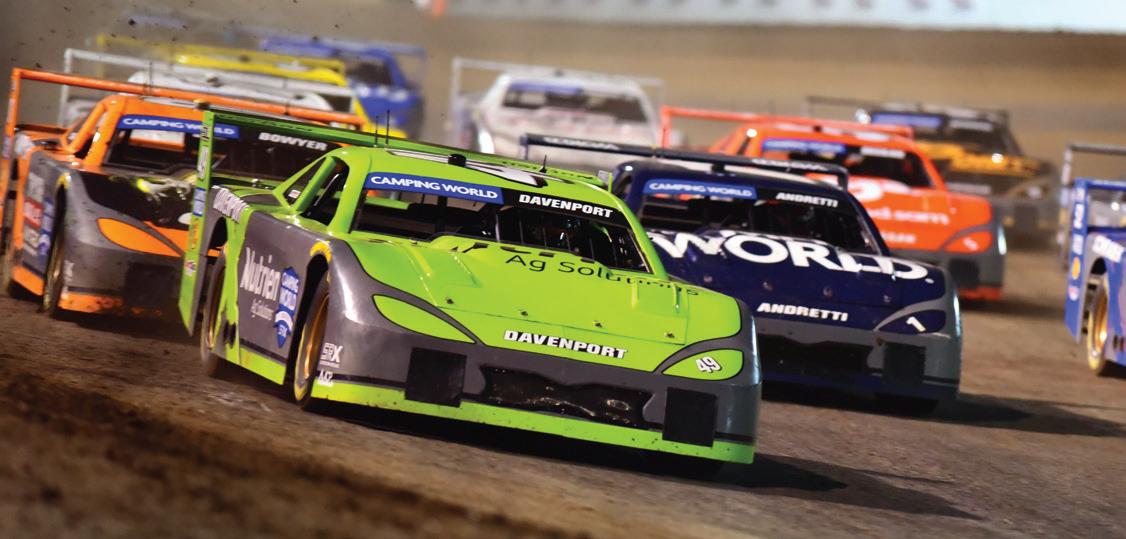

LATE MODEL STAR Jonathan Davenport got a late invitation to join the Super Racing Experience (SRX) series for their Thursday Night Thunder finale at Lucas Oil Speedway in Wheatland, Missouri, and the biggest question was whether the dirt track star with so many laps at the track should be considered the favorite or a major underdog in a race car that he’d never sat in prior to the event?
Wherever you had Davenport
pre-race, he left no doubt post-race on who was the man to beat as he led every lap of the event and held off the charges of Kurt Bowyer - a NASCAR star with dirt track experience – to wire the field for the win.
“I’m speechless. This is awesome,” Davenport said on the ESPN Thursday Night Thunder broadcast. “This is just such an awesome experience. Thanks so much to SRX for giving me this opportunity to come out here to race with some of my heroes, some legends, some superstars. I’m just and ol’ country boy
from Georgia that runs dirt cars. I didn’t know Clint was going to slide me right there. I would’ve let him go on across but I hit him right at the right time. I was already back in the gas. I knew he was going to come back again so I just lifted and somebody else took us three wide.”
After surviving the threat from Bowyer, Davenport bested Brad Keselowski and Ken Schrader for his major victory.
PHOTOS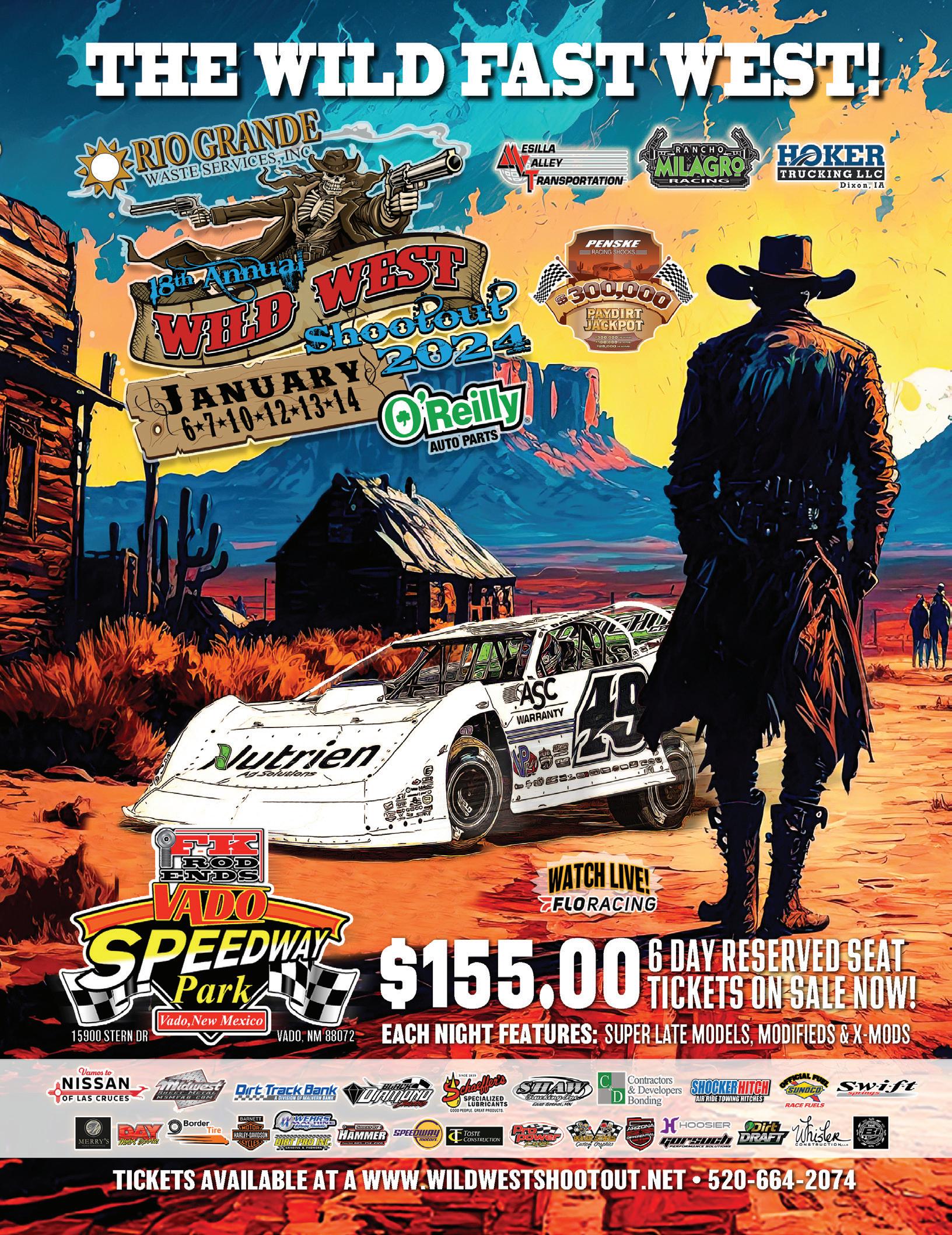

Tony Stewart’s SRX continues to gain steam and has been playing to good crowds and ratings on Thursday nights on ESPN.
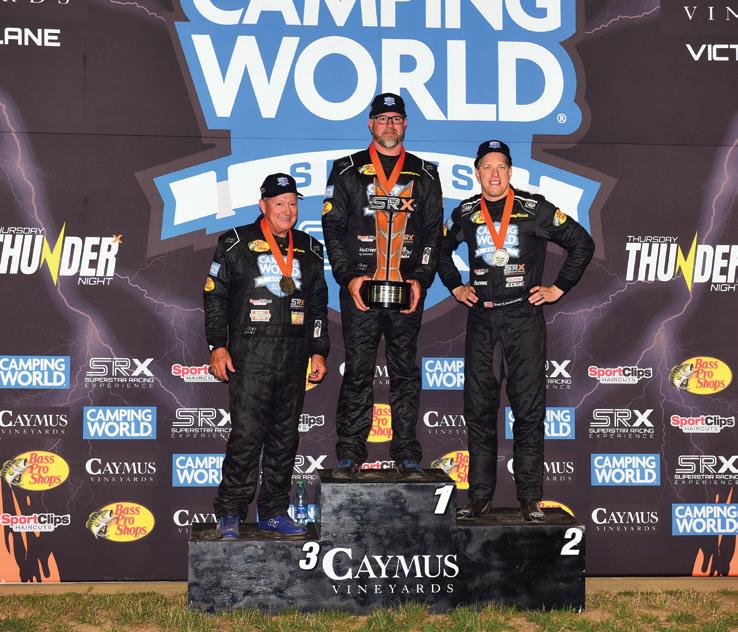
 Davenport takes the top step over NASCAR’s Brad Keselowski and everyman legend Ken Schrader.
Davenport takes the top step over NASCAR’s Brad Keselowski and everyman legend Ken Schrader.

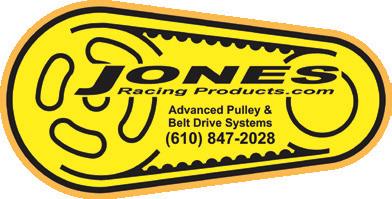
WHEN YOU MENTION Pro Power Racing engines immediately decades of victories come to mind, and that’s by no means a mistaken notion. Bill and wife, Josie, Schlieper own and operate Pro Power Racing in Sullivan, Wisconsin, and they found success early on in their engine building careers.
“Things really started rolling around 2002 when we added on to the building and got a real dyno room up and running where we could see the data,” Bill Schlieper said. “Once we could learn from what was going on, we were able to make some big improvements. We won our first World 100 in 2002, with Birkey [Brian Birkhofer] running one of our engines. When it happens so early, you think, wow, nothing can beat that feeling. But then, a year later, my brother Dan [Schlieper] won the World 100. You know, two in a row! And, he was the first driver from Wisconsin to win the World 100. So right out of the gate we had some major success, and we’ve just tried hard to build upon that ever since.”
It hasn’t always been success though.

Challenges arise from unexpected areas.
“A few years back we had a great engine that was just beating everybody,” Schlieper said. “Then the sanctioning bodies, at least one of them, said no more aluminum blocks. That was pretty frustrating. These sanctioning bodies are always talking about trying to keep costs down, and then they make a rule that seams to be targeted, and it renders the racer’s equipment useless. Then when it becomes tougher and tougher to get a steel blocks, prices just keep going up and up. Keeping pricing down for engines has been difficult over the last few years.”
When it comes to building engines, Bill can’t do it all on his own. The Schliepers
rely on help around the shop to churn out their top-tier engines, “My dad, who is 85, still helps around the shop, he’s not going to stop, I think, ever,” Schlieper said. “Then we have, of course, my wife Josie, John, Jerry, Scott, Rich, and Jimmy who all help out. There’s decades and decades of experience there. We’re all old-school guys. But, we’re looking to add some employees. It’s probably one of the bigger challenges we face right now, young workers willing to learn and take this knowledge on.”
Another issue plaguing the industry has been getting parts and components from suppliers.
“It was getting tough even before Covid



shut everything down. Now we have to stock more than we probably should just to make sure we have what we need when we need it,” Schlieper said. “When it comes to Jones Racing Products though, they are one of those companies we probably should have started working with sooner. They go way above and beyond what we’re used to with suppliers. They allow us to send them changes and drawings and they get us what we need. We never have to worry about parts from Jones.”
It’s important to have a solid supply chain when your company is churning out 250-300 engines every year used in all levels of racing, ranging from dirt late model and open modified big blocks to 4x4 off-road truck or asphalt late model competitions. Whatever level of racing, Pro Power Racing produces engines that win. When building championshipcaliber engines, it helps to start with the best components. But that’s not the only thing that crafts a great engine builder.
“It always goes back to customer support,” Schlieper said. “We’re on the phone with our customers helping them work through whatever they need. When you have so many engines out there all across the country, doing track support can be tough, but we do our best to make sure we provide the support our customers need.”
As the wins continue to pile up, complacent is not something Schlieper knows how to be.
“We’re going to keep doing what we know how to do, and that’s build great engines that are reliable and dependable.”



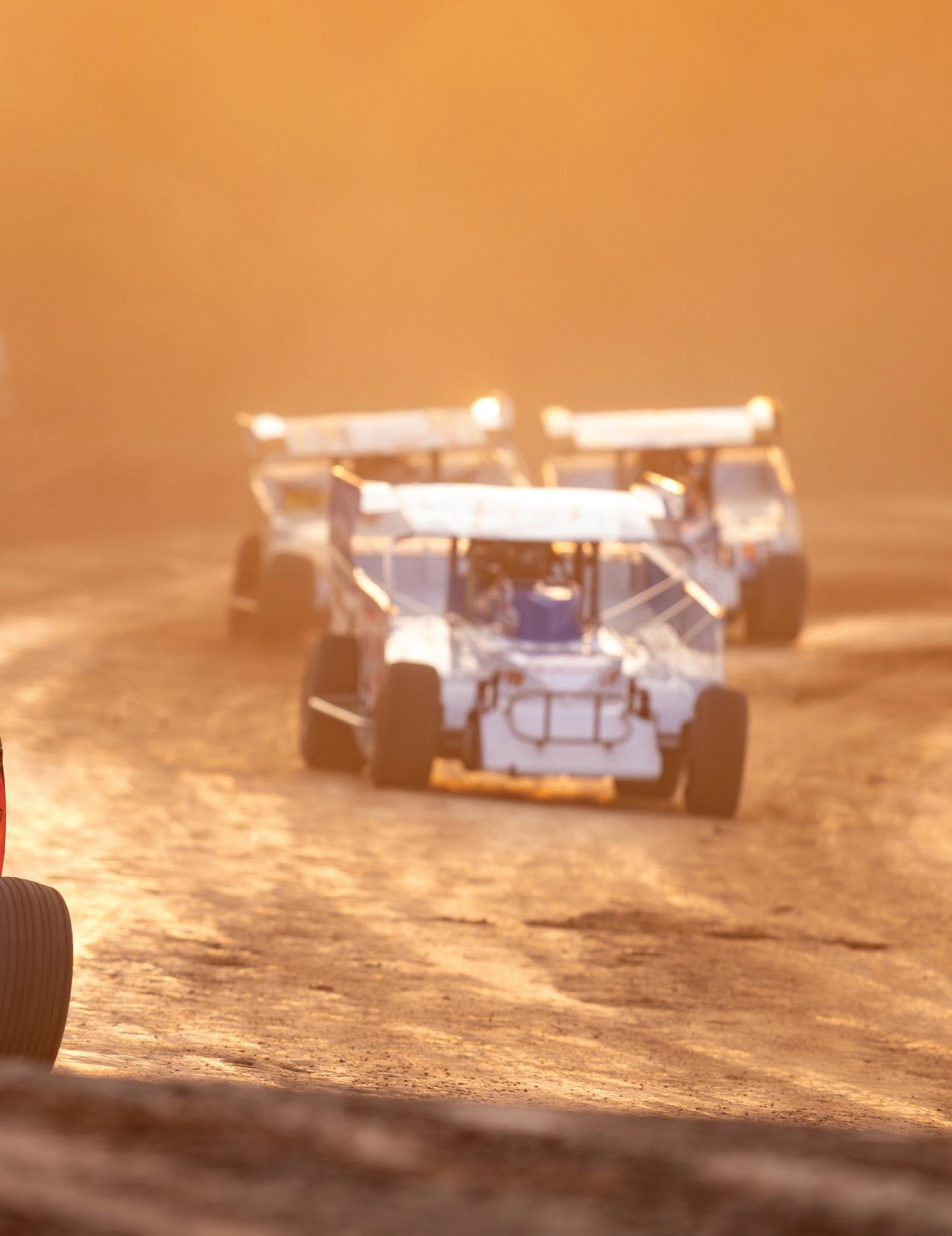
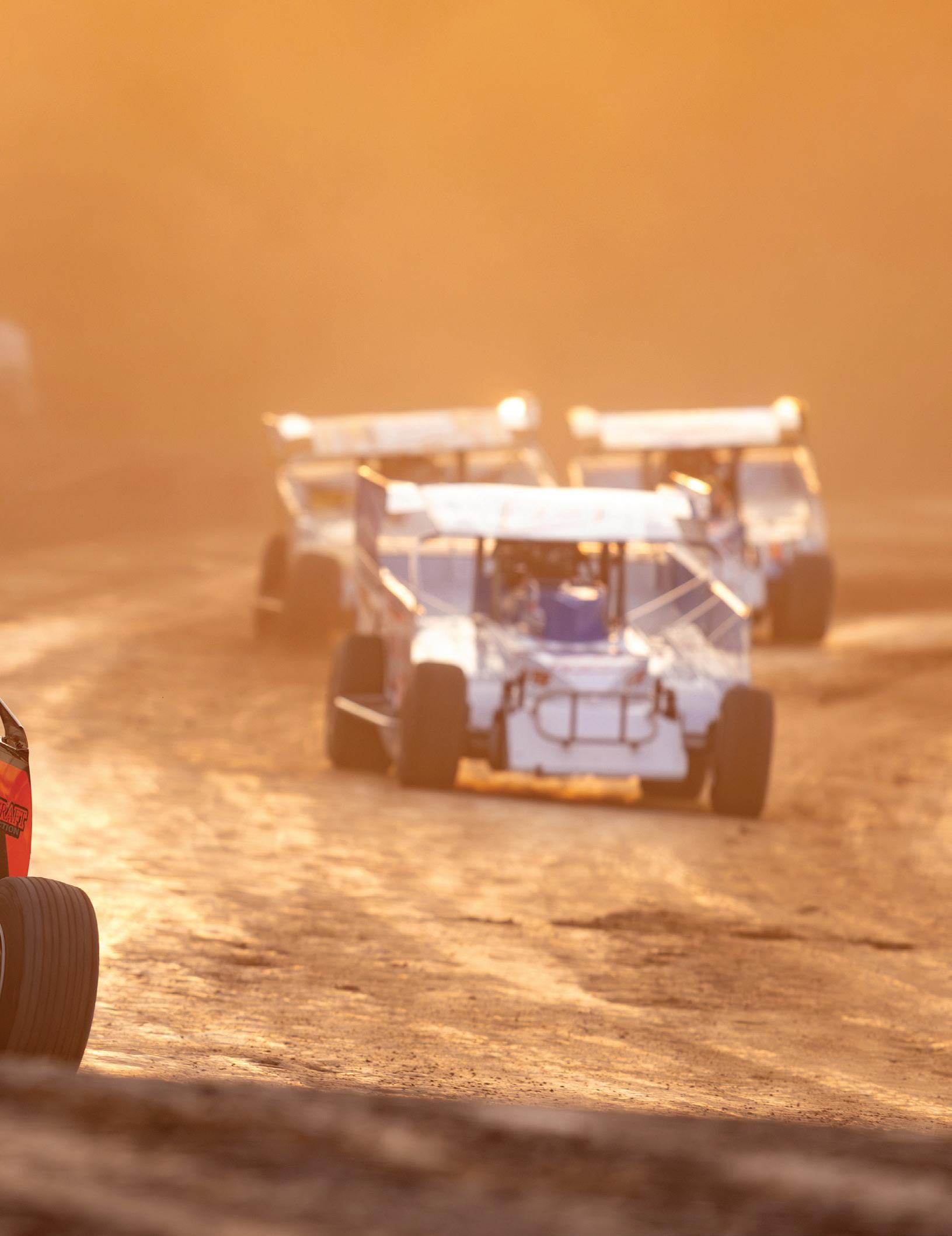
For over 50 years, the whole of dirt late model racing has turned its focus to Eldora Speedway and the World 100 in early September for the most prestigious event in the sport. It draws the most rabid fans and best drivers and the sport’s best photographers answer its siren call. It offers the rare opportunity to capture a truly great shot of a moment that could forever alter the history of the sport. Dirt Empire is home to the sport’s best photographers and we asked them to dig into their files and submit their favorites from over the years at the World 100 to showcase shots of the biggest moments and the little moments that make every World 100 special. Thank you to Tony Hammett, Paul Arch, and Mike Ruefer for shooting for so many years and for documenting and archiving the rich history of the World 100.

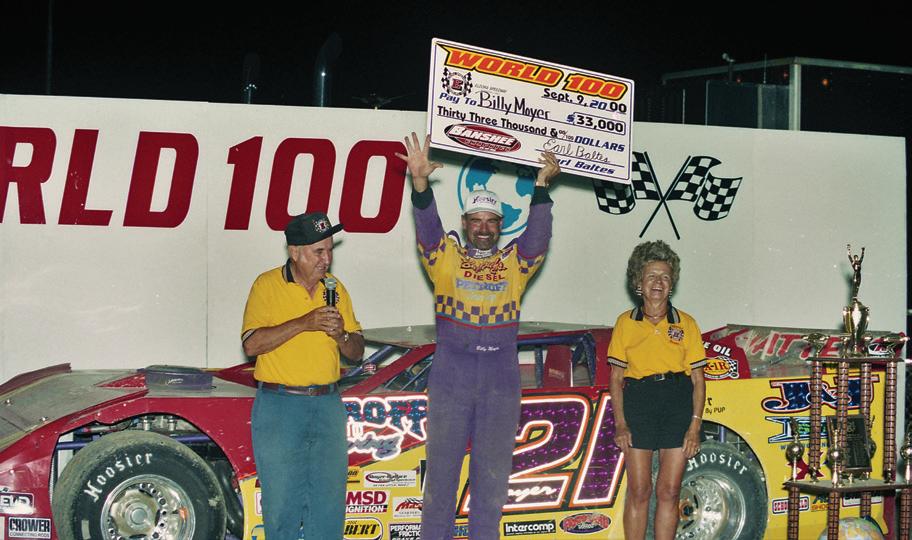
 Photo: Tony Hammett
Photo: Tony Hammett
Photo: Tony Hammett
Photo: Tony Hammett
Photo: Tony Hammett
Photo: Tony Hammett
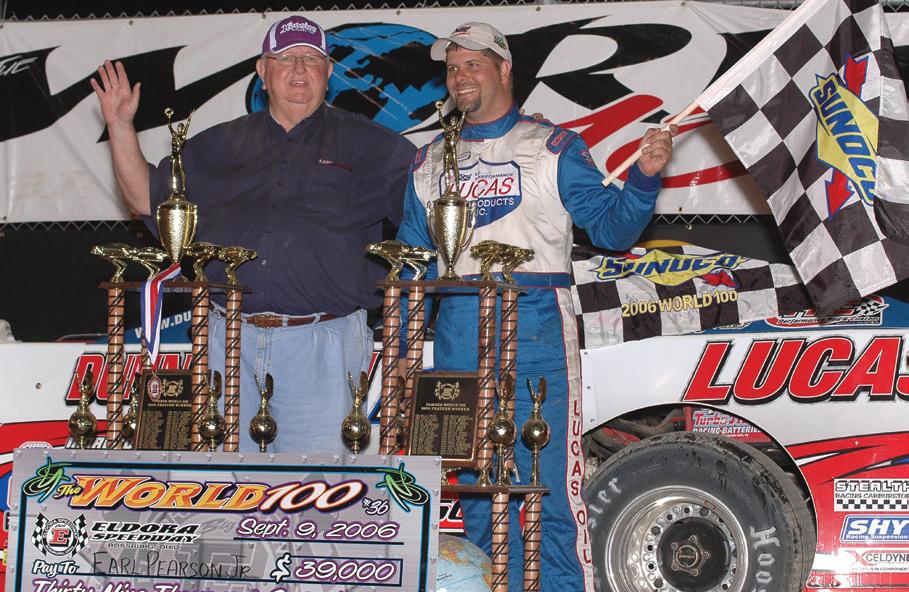
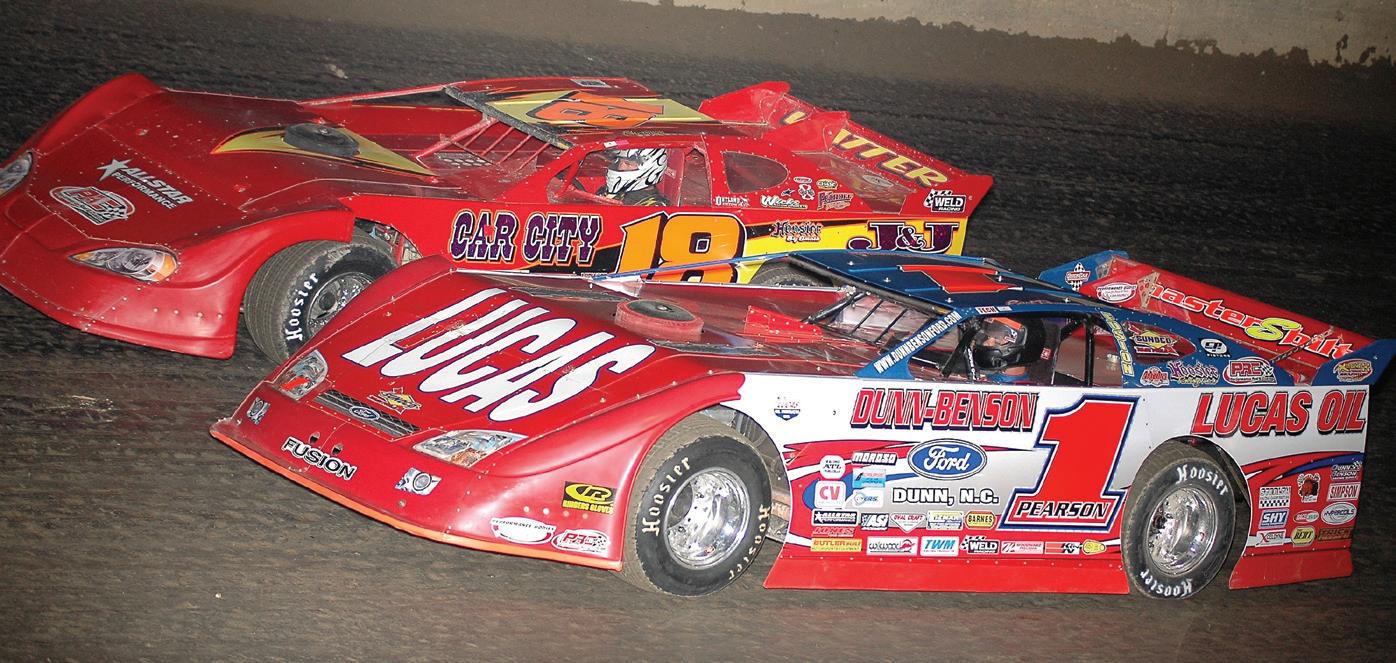

2000 was a recordbreaking year with 261 entries for the World
Photo: Tony Hammett Photo: Tony Hammett Photo: Tony Hammett (Top and Middle) The 2006 edition is one that many race fans still hold as one of the best ever held and Earl Pearson Jr. scored his one and only win and celebrated with Carlton Lamm in victory lane. Pearson started his Lucas Oil 1 alongside Shannon Babb’s 18 and the two put on a classic duel. Photo: Tony Hammett
Photo: Tony Hammett
There’s been some big ones over the years and 2004 saw Kevin Claycomb landed atop Chad Smith in this vicious tangle.



In 2010, Tim McCreadie joined several celebs who trimmed their locks for charity. Alas, Scott Bloomquist sat this one out! It took 8 years for T-Mac’s good karma to kick in when he won his first World 100 in 2018.
Photo: Tony Hammett Photo: Paul Arch Photo: Paul Arch
 2015 saw a Jonathan Davenport victory in front of a packed house. Davenport shares the emotional win with the late Lee Roy Rumley and his son Kevin Rumley. This was the first of his five World 100 wins.
Photo: Mike Ruefer
2015 saw a Jonathan Davenport victory in front of a packed house. Davenport shares the emotional win with the late Lee Roy Rumley and his son Kevin Rumley. This was the first of his five World 100 wins.
Photo: Mike Ruefer


Dirt Empire Magazine is proud to have assembled a crack staff of freelance photographers and writers who blend their passion for the sport with their talent and artistry to make these pages pop. If you see an image that you’d like to own or need a great image for your shop, shoot them a messge and support them.
Allyson Bane - allyson.r.bane@gmail.com
Ashley Zimmerman - amjzimm55@gmail.com
Bob Mays - catsracin@yahoo.com
Jeff Bylsma - randrplumbing@mtcnet.net
Joe Orth – joeorthphoto@aol.com
John Lee - highfly-n@comcast.net
Josh James – joshjamesphotos@gmail.com
Mark Funderburk - funderburkracnfoto@gmail.com
Matt Butcosk – mbutcosk@gmail.com
Michael Moats – mrm4@comcast.net
Mike Campbell – mikecampbellphotos@gmail.com
Mike Feltenberger - starterone@aol.com
Mike Ruefer - mikerueferphotos@gmail.com
Nicole Signor – nsignorcreative@gmail.com
Paul Arch - peanumber10@comcast.net
Quentin Young - quentinyoungphoto@yahoo.com
Rich LaBrier – dirtmanphoto@gmail.com
Ryan Roberts - jryanroberts@ymail.com
Scott Bender - zrobert15@comcast.net
Todd Boyd – latemodel1967@gmail.com
Tony Hammett - tony.hammett@charter.net
Tyler Carr - tcarr95vc@gmail.com
Zach Yost - zyost11@yahoo.com
I HAVE BEEN HEAVILY involved in sprint car racing for the past eight years, and really focused on growing my name and business, Nicole Signor Creative, across the industry, as a professional graphic designer, photographer, and social media manager working for several teams – I decided to give the Knoxville Queens Contest a shot this year, with goals to push my career further while inspiring the next generation to pursue more than driving a race car.
After having competed in three other motorsports competitions in Pennsylvania, I wanted to give the Knoxville Nationals Queens Contest a try before I aged out next year. For entry, contestants must be under 30 years old, showcase a passion in sprint car racing and Knoxville Raceway; I fit that bill to a T.
After entering, Christi Woodruff [coordinator] phoned each contestant to both welcome them, and answer any questions we may have, while explaining what to expect. The contest day is the Tuesday prior to the start of the Nationals. It begins with a luncheon and interview with the judges. Contestants are expected to dress comfortable, while maintaining professionalism. I began my interview

shaking the hands of each judge, while introducing myself. While some recognized me from being a part of the media, I was asked several questions regarding my role as a woman in media. Questions also included how winning the contest could change my future. Even though I fidgeted a bit from nerves, I felt my interview went well.
The evening portion begins with another introduction, now to race fans, where I was able to share my experience attending Knoxville for the #ReturntoRacing event at the start of Covid. The final portion of the evening involves returning to the stage in a formal gown, while selecting a judge at random from a basket to ask one final racing question. As the last contestant to return, much like the pill draw, my fate was chosen for me. I was asked, by one of the judges who happened to be Dirt Empire’s Ashley [Zimmerman], “what is one question you’d ask a driver, if given the opportunity?” My answer was simply, “I’d ask, what is the hardest part of their season, mental, emotional, or physical”.
The Knoxville Nationals Queen’s contest is unlike the others I have entered and was a very positive experience. If you’re a female that has a love for Knoxville, and sprint car racing, it’s something to consider entering. You will make wonderful connections throughout racing!
While after the scores were tallied, I fell outside the top three and did not make the Nationals Queen’s court, I still fulfilled another goal of mine - to shoot the Knoxville Nationals and even from the flag stand! I am very thankful for Christi Woodruff and Justin Clark for allowing me these opportunities!
Check out Nicole’s work in our Knoxville Nationals coverage, including her amazing shot from the flagstand.







